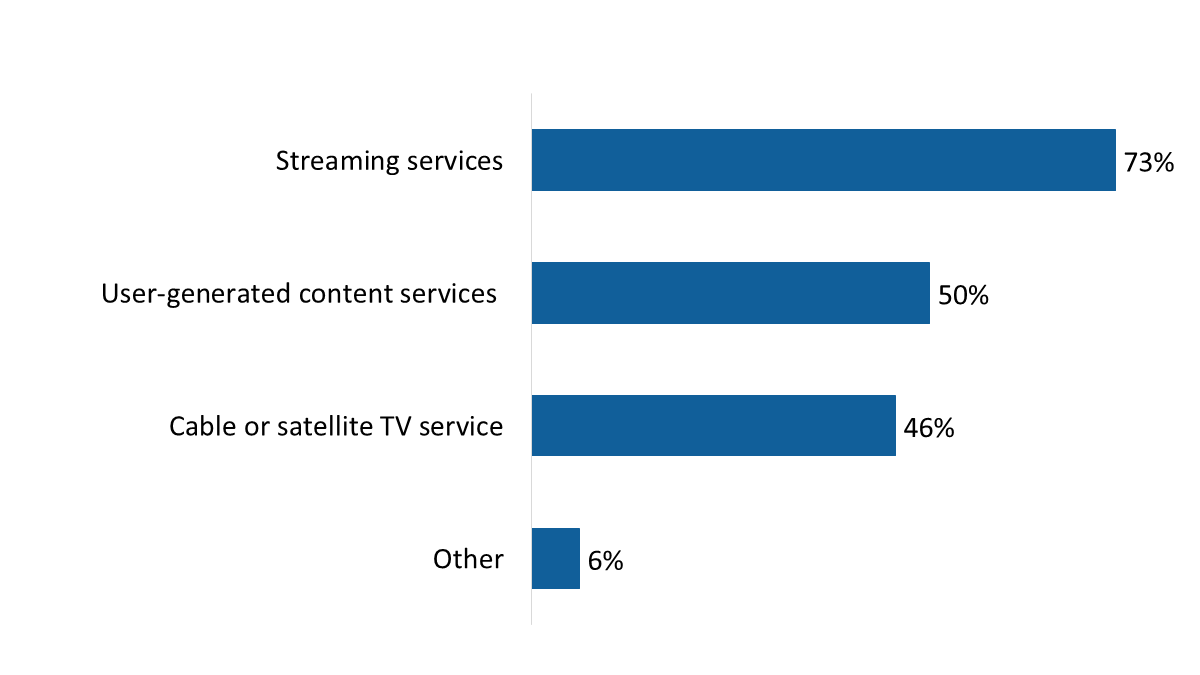
Final Report
Prepared for the Canadian Radio-television and Telecommunications Commission (CRTC)
Supplier Name: Phoenix SPI
Contract Number: CW2374506
Award Date: 2024-09-23
Contract Value: $128,735.25 (including applicable taxes)
Delivery Date: 2025-02-17
Registration Number: POR 038-24
For more information on this report, please contact the CRTC at ROP-POR@crtc.gc.ca.
This public opinion research report presents the results of a 10-minute online survey of 1,226 Canadians aged 16 years of age and older and eight online focus groups, four in English and four in French, conducted with Canadians aged 18 and older. The fieldwork took place from 13 to 21 November 2024 (virtual focus groups) and from 15 November to 5 December 2024 (online survey).
Cette publication est aussi disponible en français sous le titre: Les perceptions au sujet de la programmation canadienne et des nouvelles
Permission to Reproduce
This publication may be reproduced for non-commercial purposes only. Prior written permission must be obtained from the CRTC. For more information on this report, please contact the CRTC at ROP-POR@crtc.gc.ca or at:
Canadian Radio-television and Telecommunications Commission
1 Promenade du Portage
Gatineau, Québec J8X 4B1
Catalogue Number: BC92-138/2025E-PDF
International Standard Book Number (ISBN): 978-0-660-75419-2
Related publication (Registration Number: POR 038-24):
Catalogue Number: BC92-138/2025F-PDF
ISBN: 978-0-660-75420-8
© His Majesty the King in Right of Canada, as represented by the Canadian Radio-television and Telecommunications Commission, 2025.
The Canadian Radio-television and Telecommunications Commission (CRTC) commissioned Phoenix Strategic Perspectives (Phoenix SPI) to conduct quantitative and qualitative public opinion research (POR) to support the development of new policies following changes to the Broadcasting Act.
The purpose of this research was to reflect the views and attitudes of Canadians and Indigenous Peoples regarding Canadian audiovisual programming and audiovisual and audio news programming. The specific objectives were to determine the following: the importance and value of Canadian programming; ease of access to Canadian programming; the types of news programming that are important to Canadians; the differences in availability of news between urban and rural areas; and views on the quality and diversity of Canadian news.
The research included a 10-minute probability online survey of 1,226 Canadians aged 16+ and eight 90-minute virtual focus groups with Canadians aged 18+. The online survey included an oversample of Canadians living in rural areas or northern communities, and those living in English or French official language minority communities (OLMCs). The target populations for the focus groups were those living in English and French OLMCs, members of equity-deserving groups, Canadians living in rural areas or in the Territories, and Canadians living in urban areas. Separate groups were conducted with each audience. Equity-deserving groups included Black and other racialized persons, people who identify as 2SLGBTQI+, women, and persons with disabilities. The fieldwork took place from 13 to 21 November 2024 (virtual focus groups) and from 15 November to 5 December 2024 (online survey).
The findings from this POR will be placed on the record of The Path Forward – Defining "Canadian program" and supporting the creation and distribution of Canadian programming in the audio-visual sector, Broadcasting Notice of Consultation CRTC 2024-288.
The contract value was $128,735.25 (including applicable taxes).
I hereby certify as a Senior Officer of Phoenix SPI that the deliverables fully comply with the Government of Canada political neutrality requirements outlined in the Communications Policy of the Government of Canada and the Procedures for Planning and Contracting Public Opinion Research. Specifically, the deliverables do not contain any reference to electoral voting intentions, political party preferences, standings with the electorate, or ratings of the performance of a political party or its leader.
(original signed by)
Alethea Woods
President
Phoenix Strategic Perspectives Inc.
The CRTC is an administrative tribunal that is responsible for regulating and supervising broadcasting and telecommunications in Canada. The CRTC’s activities are guided by policy objectives set out in the Broadcasting Act, the Telecommunications Act, and Canada’s Anti-Spam Legislation.
On 27 April 2023, Bill C-11, known as The Online Streaming Act, received royal assent, modernizing the Broadcasting Act. The CRTC is now updating its policies and approaches to implement the modernized Act, which grants the CRTC clear powers and tools to regulate online streaming services operating in whole or in part within Canada, regardless of their country of origin. Two key components are Canadian programming and news. In preparation for developing new policies following amendments to the Broadcasting Act, the CRTC commissioned public opinion research (POR) to assess the views and attitudes of Canadians on Canadian audiovisual programming and news.
The specific objectives of this POR were to determine the following:
The findings from this POR will be added to the record of The Path Forward – Defining "Canadian program" and supporting the creation and distribution of Canadian programming in the audio-visual sector, Broadcasting Notice of Consultation CRTC 2024-288. This is the hearing on perceptions about Canadian programming and news that will help develop regulatory frameworks for Canadian programming and news.
This POR included both quantitative and qualitative components:
More information on the methodology can be found in the Appendix, under Technical Specifications.
AI - artificial intelligence
CRTC - Canadian Radio-television and Telecommunications Commission
FSA - forward sortation area
GPRS - General Population Random Sample
OLMC - official language minority communities
Phoenix SPI - Phoenix Strategic Perspectives
POR - public opinion research
This section of the report focuses on the viewing habits of research participants. The survey findings are presented first, followed by the focus group findings.
Nearly three-quarters of survey respondents (73%) said they use streaming services like Netflix, Disney+, TOU.TV, or Crave to access video programming. Exactly half (50%) access video programming through user-generated content services like TikTok or YouTube, while close to half (46%) do so through cable or satellite TV services. Six percent of respondents said they typically access video programming through some other method.

| Streaming services | 73% |
| User-generated content services | 50% |
| Cable or satellite TV service | 46% |
| Other | 6% |
Q1 - How do you typically access video programming? [Multiple responses accepted] Base: n=1,226; all respondents.
Use of cable or satellite TV services increased with respondents’ age, while use of user-generated content services was higher among Canadians under 35 years of age and Canadians with disabilities.Footnote 2
In a typical day, more than eight in 10 (82%) respondents watch video programming for at least one hour. Fifty-seven percent do so for one to three hours and 25% for more than three hours. Conversely, 15% typically watch less than one hour of video programming a day and 2% reported not watching programming daily. Video programming includes video programming on cable or satellite TV services or online streaming services.
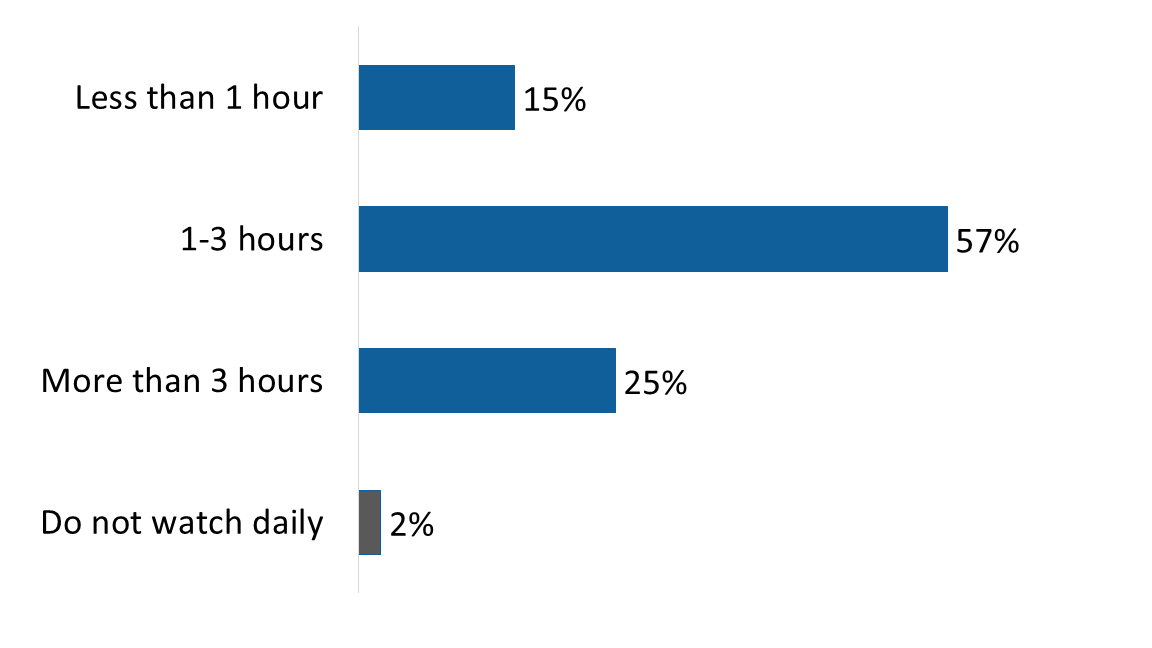
| Less than 1 hour | 15% |
| 1-3 hours | 57% |
| More than 3 hours | 25% |
| Do not watch daily | 2% |
Q2 - How often do you watch video programming in a typical day? Base: n=1,226; all respondents, excluding “don’t know” n=8.
Approximately two-thirds (68%) of respondents said they primarily watch drama and comedy programs, while more than half watch news (61%) and movies (57%). Half (51%) of respondents reported watching documentaries and a third (32%) primarily watch sports.
Eleven percent of respondents reported watching other types of video programming, including YouTube shorts, fantasy/sci-fi series, talk shows, mysteries, reality programming, children’s programming, Anime, and lifestyle programming such as gardening, cooking, and home improvement shows.
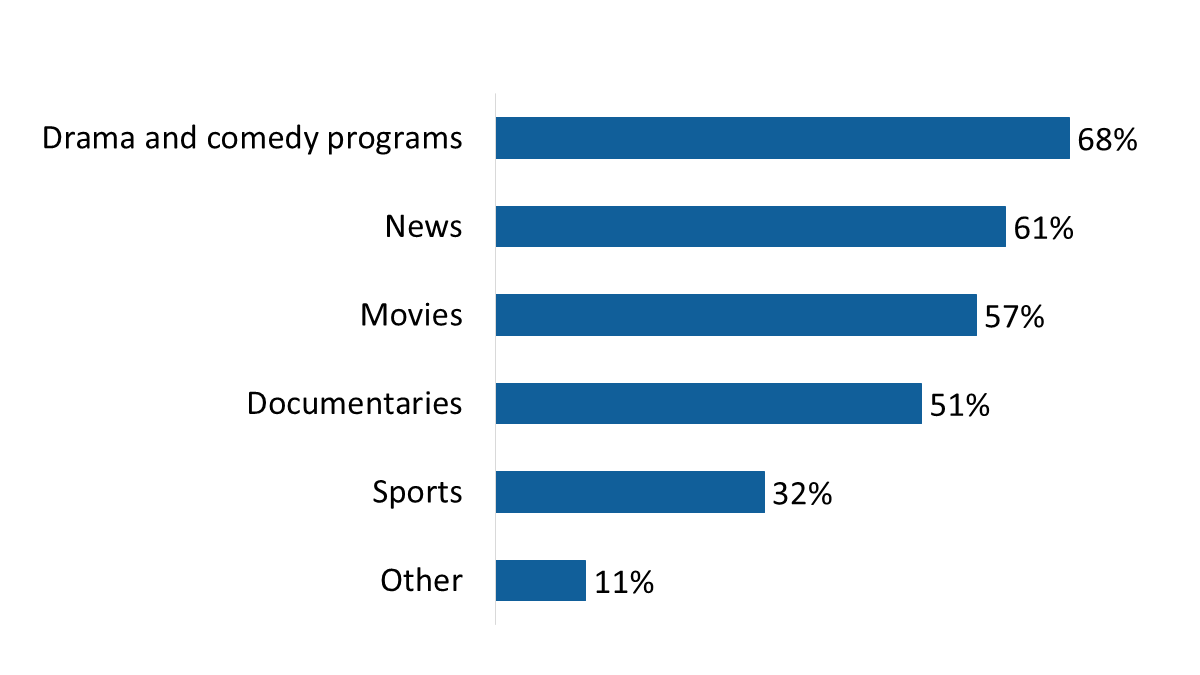
| Drama and comedy programs | 68% |
| News | 61% |
| Movies | 57% |
| Documentaries | 51% |
| Sports | 32% |
| Other | 11% |
Q3 - What type of video programming do you primarily watch? [Multiple responses accepted] Base: n=1,226; all respondents. Respondents were able to select from a list of responses, as well as volunteer other types of programming that they watch.
Respondents under 35 were less likely to watch news programming while those aged 65+ were the most likely to do so.
Almost three-quarters of surveyed Canadians said that entertainment value (72%) and overall quality (72%) are the factors that influence their decision to watch video programming. Approximately half of respondents said their decision is influenced by genre preference (i.e., their preference for specific types of programming, such as drama or comedy) (51%) or a recommendation (49%). Smaller numbers of respondents identified other factors influencing their decision: cultural relevance (35%), language (30%) and diversity (28%) of content, and accessibility (i.e., ensuring programming is available to all audiences, including those with disabilities) (16%). Three percent of respondents reported being influenced by other factors,such as program ratings or reviews, mood when watching programming, and information quality.
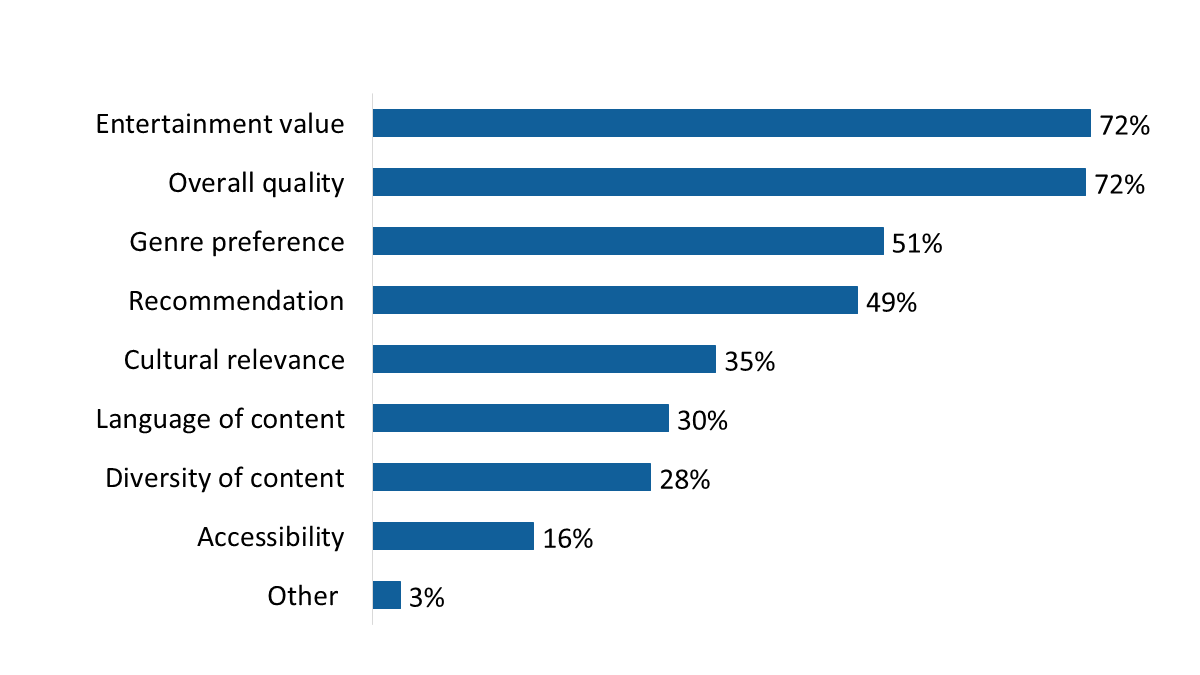
| Entertainment value | 72% |
| Overall quality | 72% |
| Genre preference | 51% |
| Recommendation | 49% |
| Cultural relevance | 35% |
| Language of content | 30% |
| Diversity of content | 28% |
| Accessibility | 16% |
| Other | 3% |
Q8 - What factors influence your decision to watch video programming? [Multiple responses accepted] Base: n=1,226; all respondents excluding “don’t know” n=24. Respondents were able to select from a list of responses, as well as volunteer other factors.
Cultural relevance and language are more likely to influence the viewing decisions of members of OLMCs, in particular French OLMCs. French OLMCs, on the other hand, were less likely than other Canadians to attribute importance to entertainment value. Respondents under 35 were the most likely to say that genre preference is a factor influencing their decision to watch video programming. Racialized respondents were more likely to point to diversity of content as something that influences the programming they watch. Canadians with disabilities were more likely to mention genre preference and accessibility when it came to factors influencing their decision to watch programming. Cultural relevance, genre preference, and diversity were more likely to be important to those who identify as part of the 2SLGBTQI+ community.
Among focus group participants, nearly everyone said that they watch programs via online streaming services, and most indicated that they subscribe to more than one such service. Some participants indicated that they watch programs through cable or satellite subscription, usually in tandem with a subscription to streaming services. A few participants who use streaming services emphasized that they stopped using cable service some time ago, and a few who have retained cable explained why they have done so. Among these reasons was a desire to watch regularly scheduled programming in real time, particularly news and sports.
Focus group participants reported watching a range of programming, most often a combination of news/current affairs and entertainment programming. News/current affairs was the type of programming participants most frequently reported watching. Other types of programming participants reported watching included documentaries and investigative journalism, sports, movies, and televised series, such as comedies, dramas, crime, mysteries, talk shows, game shows, variety shows, repair shows, children’s programming, reality TV, and programs relating to home improvement/renovation, cooking/food, travel, cars, history, and technology. When describing their viewing habits, some Francophone participants specified that they watch French or Quebec programming, as well as programming that has been translated into French.
Among focus group participants, factors that influence their choices about what programming they watch included the following:
A few Francophone participants specified that their choices are also determined by what programs are available in French, including what has been translated or dubbed into French.
Focus group participants also identified a variety of programming elements that resonate with or matter most to them. These elements and qualities included the following:
Focus group participants were asked whether their viewing habits have changed over the past few years. Most said their habits have changed when it comes to watching video programming. In describing how their habits have changed, participants most often indicated that they have shifted to online streaming services, occasionally specifying that this took place as a result of improved Internet access or the pandemic.
Participants identified a number of other ways in which their habits have changed, some of which are associated with participants’ subscription(s) to streaming services. These include:
This section focuses on issues related to Canadian programming. The survey findings are presented first, followed by the focus group findings.
Six in ten (60%) Canadians said they can identify Canadian programming when looking for something to watch on cable, satellite or online streaming services. Among the rest, one-quarter (25%) indicated they cannot identify Canadian programming and 16% were uncertain.
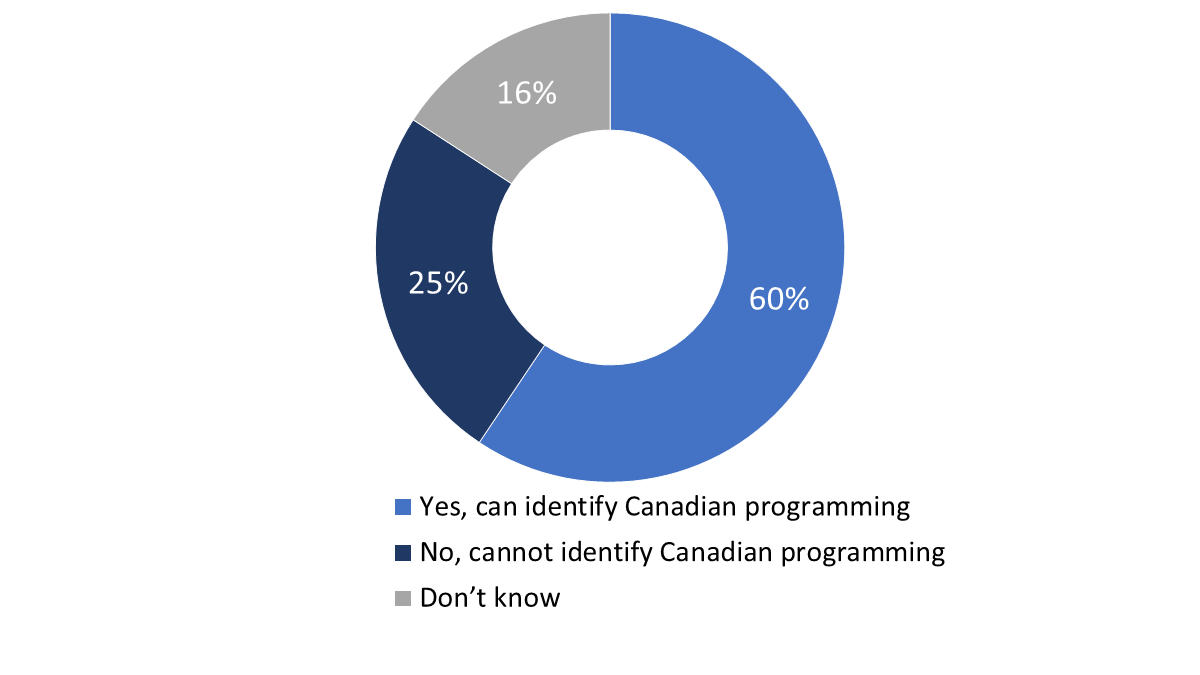
| Yes, can identify Canadian programming | 60% |
| No, cannot identify Canadian programming | 25% |
| Don’t know | 16% |
Q5 - Can you identify Canadian programming when looking for something to watch on cable, satellite or online streaming services? Base: n=1,226; all respondents
Canadians under 35 were more likely than older Canadians to say they cannot identify Canadian programming.
Nearly three-quarters of Canadians surveyed (72%) said they identify Canadian programming as stories that are set in a Canadian locationFootnote 3. Following location, just over half indicated that reflecting Canadian realities (58%) or featuring Canadian actors (56%) are the measures they use to identify Canadian programming. Approximately half of the respondents (51%) associated Canadian programming with Canadian stories. A little over one-quarter (29%) considered the people behind the camera when identifying Canadian programming (i.e., if those behind the camera are Canadian, then the programming is Canadian).
Twelve percent of respondents identified Canadian programming in other ways, including, for example, word of mouth, the program credits, lower production quality, whether there is a Government of Canada logo at the end of the program, language of the production, and the network on which it airs (i.e., if it airs on CBC, then it’s Canadian).

| Stories are set in a Canadian location | 72% |
| Programming reflects Canadian realities | 58% |
| Actors are Canadian | 56% |
| Based on a Canadian story | 51% |
| People behind the camera are Canadians | 29% |
| Another way | 12% |
Q7 - How do you identify Canadian programming? [Multiple responses accepted] Base: n=1,226; all respondents. Respondents were able to select from a list of responses, as well as volunteer other ways.
While respondents associate stories set in a Canadian location with Canadian programming, surveyed Canadians said that the CRTC’s priorities for Canadian programming should be much broader. Respondents were informed of the CRTC’s role in Canadian programmingFootnote 4 and then asked to consider this role and indicate how important each of the following priorities are to them personally:
All priorities are at least somewhat important to a majority of surveyed Canadians. Half or more said the following are very important priorities: Canadian jobs in the entertainment industry (58%), Canadians having creative control over their productions (58%), Canadian programming being well funded (51%), and Canadians having financial control of their productions (50%). Almost half (48%) attributed a high level of importance to filming in Canada.
Survey respondents were less likely to attribute high importance to highlighting Canadian culture and identity (38%), cultivating a sense of shared Canadian identity (38%), and promoting diversity (34%).
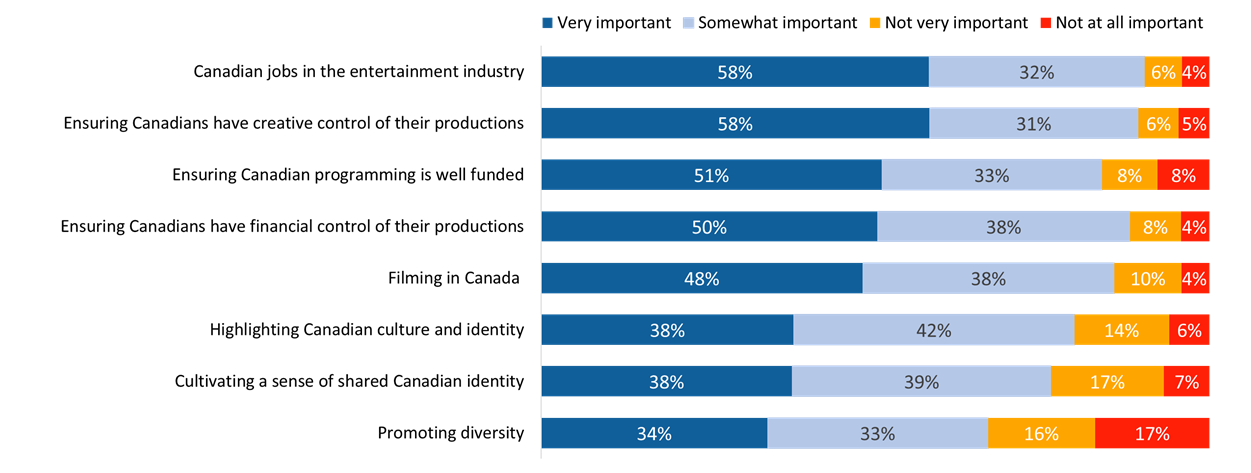
| Very important | Somewhat important | Not very important | Not at all important | |
| Promoting diversity | 34% | 33% | 16% | 17% |
| Cultivating a sense of shared Canadian identity | 38% | 39% | 17% | 7% |
| Highlighting Canadian culture and identity | 38% | 42% | 14% | 6% |
| Filming in Canada | 48% | 38% | 10% | 4% |
| Ensuring Canadians have financial control of their productions | 50% | 38% | 8% | 4% |
| Ensuring Canadian programming is well funded | 51% | 33% | 8% | 8% |
| Ensuring Canadians have creative control of their productions | 58% | 31% | 6% | 5% |
| Canadian jobs in the entertainment industry | 58% | 32% | 6% | 4% |
Q13 - Considering the CRTC's role, how important to you are each of the following priorities? Base: n=1,226; all respondents, excluding “don’t know” which ranged from n=3 to n=17.
In terms of subgroup differences:
Survey respondents were divided when it comes to the perceived importance of a program’s country of originFootnote 5. While some thought that the CRTC should focus on Canadian jobs in the entertainment industry and funding Canadian programming, and Canadians having creative and/or financial control over their productions, just under half (47%) said country of origin is not very or not at all important. Those who feel country of origin is important were more likely to believe that it is somewhat important (37%) as opposed to very important (15%).
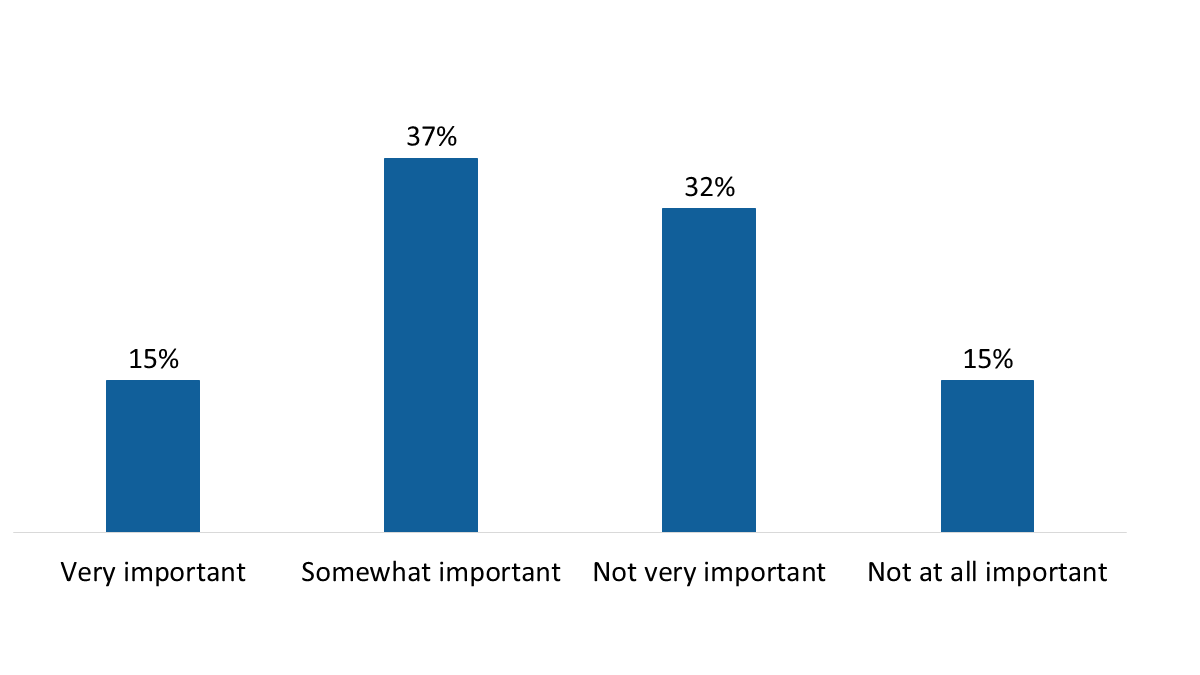
| Very important | 15% |
| Somewhat important | 37% |
| Not very important | 32% |
| Not at all important | 15% |
Q6 - How important to you, if at all, is a program’s country of origin? Base: n=1,226; all respondents, excluding “don’t know” n=4.
Language has an impact on perceptions of the importance of a program’s country of origin. Specifically, members of OLMCs, in particular French OLMCs, and those who speak French at home most often were more likely to attribute importance to a program’s country of origin. Additionally, Canadians under 55 years of age were more likely than Canadians aged 65+ to report that country of origin is not very or not at all important.
There was more consensus among survey respondents when it came to the content of Canadian programming. Exactly three-quarters said it is very (31%) or somewhat (44%) important that Canadian programming reflects Canadian culture and identity. In contrast, one-quarter (26%) said it is not very or not at all important.

| Very important | 31% |
| Somewhat important | 44% |
| Not very important | 17% |
| Not at all important | 9% |
Q12 - How important is it to you that Canadian programming reflects Canadian culture and identity? Base: n=1,226; all respondents, excluding “don’t know” n=13.
Women and members of French OLMCs were more likely to view as important Canadian programming reflecting Canadian culture and identity. Compared to Canadians aged 65+, those under 35 were more likely to say that this is not very or not at all important.
Drama and comedy programming topped the list of genres of video programming watched by surveyed respondents. When it comes specifically to Canadian programming, however, the type of programming that matters most to the greatest proportion of respondents is news and current affairs.
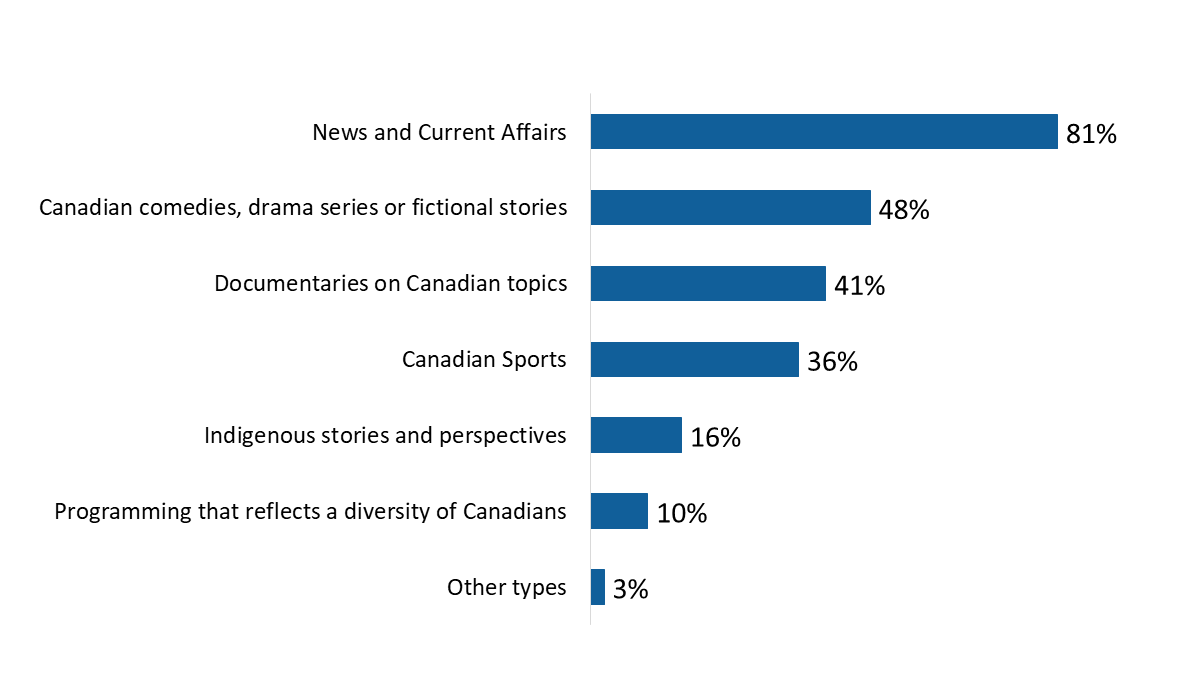
| News and Current Affairs | 81% |
| Canadian comedies, drama series or fictional stories | 48% |
| Documentaries on Canadian topics | 41% |
| Canadian Sports | 36% |
| Indigenous stories and perspectives | 16% |
| Programming that reflects a diversity of Canadians | 10% |
| Other types | 3% |
Q10 - What type(s) of Canadian programming matters to you the most? [Up to 3 responses accepted] Base: n=1,226; respondents that watch Canadian programming, excluding “don’t know” n=29. Respondents were able to select from a list of responses, as well as volunteer other types of programming.
Eight in ten (81%) survey respondents said Canadian news and current affairs programming matters to them the most. Almost five in ten (48%) mentioned Canadian comedies, drama series or fictional stories, while four in ten (41%) said documentaries on Canadian topics matter to them the most. For approximately one-third (36%) of respondents, Canadian sports matter the most. Indigenous stories and perspectives matter most to 16% of respondents and, for 10%, programming that reflects a diversity of Canadians is most important.
Three percent of those surveyed pointed to other types of Canadian programming, including, for example, animation, Canadian reality shows, and historical programming.
Indigenous stories and perspectives were most likely to matter to surveyed Canadians under 35 years of age.
Three-quarters of surveyed Canadians said they watch Canadian programming frequently (28%) or occasionally (46%), while 16% do so rarely and 2% never watch Canadian programming. A minority (8%) could not say how often they watch Canadian programming. Respondents were informed that Canadian video programming refers to media productions, like films, series and sitcoms, and videos created in Canada or by Canadians.
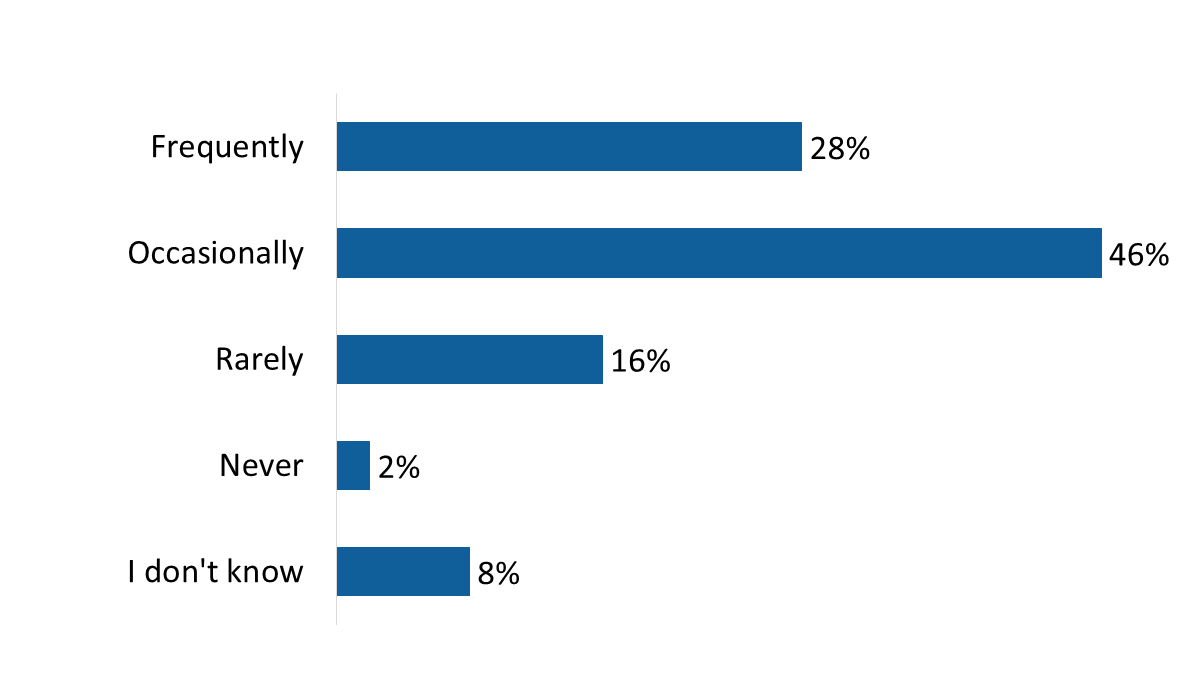
| Frequently | 28% |
| Occasionally | 46% |
| Rarely | 16% |
| Never | 2% |
| I don't know | 8% |
Q9 - How often do you watch Canadian programming? Base: n=1,226; all respondents.
Members of racialized populations and Canadians under 35 were less likely to report watching Canadian programming frequently.
Suggestions, either from friends and family (55%) or from TV and streaming services (54%), are the ways many respondents said they discover new Canadian programming to watch. In addition, almost half (48%) uses social media, while 39% discover new Canadian programming through articles or segments in news programming.
Six percent of respondents pointed to other ways they discover new Canadian programming, including, radio or newspapers, TV guides, or by chance while channel "surfing". A small number indicated that they do not look for new Canadian programming to watch.
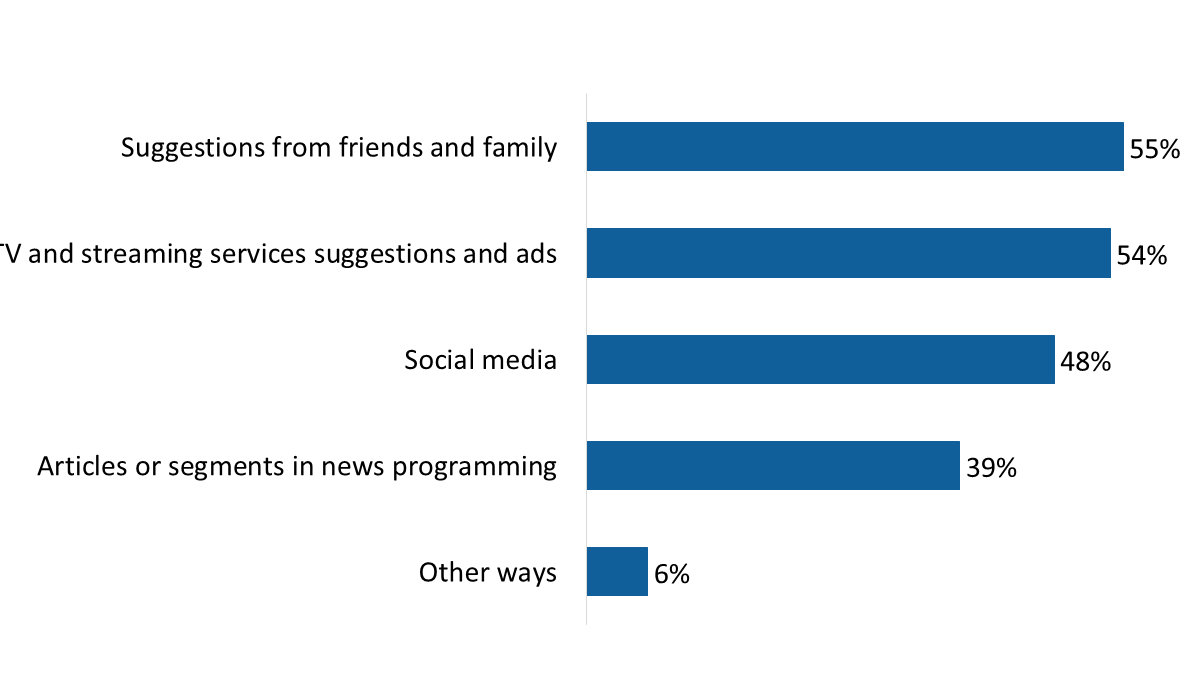
| Suggestions from friends and family | 55% |
| TV and streaming services suggestions and ads | 54% |
| Social media | 48% |
| Articles or segments in news programming | 39% |
| Other ways | 6% |
Q11 - How do you discover new Canadian programming to watch? [Multiple responses accepted] Base: n=1,226; all respondents. Respondents were able to select from a list of responses, as well as volunteer other ways of discovering Canadian programming.
Canadians under 35 years of age were least likely to report discovering new Canadian programming via suggestions and advertisements from TV and streaming services or from articles or segments in news programming.
Focus group participants had no difficulty identifying Canadian shows (excluding news and sports), with shows identified by Francophone participants being from Quebec.Footnote 6
For many focus group participants, the expression "Canadian programming" brought to mind specific programs, networks, channels, or genres of programming. This was much more likely the case among Anglophone than Francophone participants. Specific genres of programs included comedy shows, documentaries, investigative journalism, and sports.
For others, the term “Canadian programming” is associated with the following characteristics:
The tendency to focus on characteristics of Canadian programming was more likely to be the case among Francophone participants. However, the main difference between Anglophone and Francophone participants was the tendency among the latter to emphasize the distinctly Quebec or French-language dimension of such programming (usually the former)Footnote 7. Specifically, Francophone participants associated the following characteristics with Canadian programming:
By contrast, few Anglophone participants referenced French or Quebec programming in the context of the discussion about what the expression "Canadian programming" brings to mind, and those who did were usually Anglophones living in Quebec.
Some participants associated the term “Canadian programming” with quality programming, emphasizing two things:
In the context of acknowledging the quality of Canadian programming, it was noted that there was a time when identifying programming as "Canadian" was detrimental because it suggested that Canadian programming could not stand on its own merits and needed to be promoted to a Canadian audience.
For a few participants, the expression "Canadian programming" brought to mind government involvement in programming, either in the form of publicly funded broadcasting or in the form of regulatory requirements, e.g., a requirement that networks broadcast a certain amount of Canadian programming.
There was an impression among a few participants in the English-language groups that it is difficult to determine what is specifically Canadian programming because of the production of international or US shows in Canada.
Focus group participants offered a variety of reasons for watching Canadian programs. They included the following:
Asked how watching Canadian programming makes them feel about their identity as Canadians, focus group participants routinely pointed to feelings of prideFootnote 9 and connectedness. These feelings were similar among Anglophone and Francophone participants, but the latter routinely associated these feelings specifically with Quebec programming. Feelings of pride were associated with the following:
Feelings of connectedness were based on a capacity to relate to Canadian and Quebec programming as something familiar. Elements contributing to this familiarity included identifiable locations being filmed, a sense that such programming reflects who we are through culturally distinct stories/storylines, and a certain distinct style or approach (sometimes described as different from American programming which tends to be flashy, sensational, and stereotypical in terms of storylines).
When discussing the distinctness of Quebec programming, a few Francophone participants suggested that Quebec programming has a unique character compared to English Canadian programming. In their opinion, English Canadian programming aims to reach a broader international audience, which influences its style and content, whereas Quebec programming focuses more on reflecting its own cultural identity.
Some participants said that viewing Canadian programming makes them feel like they are learning and being educated or informed about Canada and Canadian realities. A few indicated that viewing Canadian programming does not elicit any particular or distinct feelings related to their identity as Canadians.
Canada’s and Quebec’s diversity were the main topics informing discussion about whether Canadian programming accurately represents Canadian culture and values. There was widespread agreement that ethnocultural, regional, linguistic, sexual and gender diversity are part of the reality of Canada and Quebec today. Based on this, many participants felt that Canadian and Quebec/French-language programming do accurately represent Canadian and Quebec culture and values because they depict the diversity that is a core element of Canada’s and Quebec’s culture. On the other hand, many participants felt that same diversity makes it difficult to identify Canadian and Quebec culture or values in a definitive way.
Participants who held the opinion that Canadian programming accurately represents Canadian and Quebec culture and values because they depict Canada’s and Quebec’s diversity were most likely to be the following:
Participants who thought diversity makes it difficult to identify and speak about Canadian culture or Canadian values tended to be English-language Canadians living in an urban area, and members of OLMC communities (English and French-speaking). It was suggested, in the group with Francophone members of OLMC communities, that the CBC is more effective than Radio-Canada at representing the regional diversity of Canada because of its pan-Canadian approach to programming. By comparison, Radio-Canada was described as focused primarily on Quebec.
Some participants felt that Canadian programming does not accurately represent Canadian culture and values, identifying specific ways in which they thought this was the case. This included the impression that political commentary on mainstream media tends to be biased, the impression that types of people are sometimes caricatured or stereotyped (e.g., older people depicted as absent minded, Canadians depicted as lovers of maple syrup), and the impression that, despite progress, more needs to be done to include ethnic diversity as well as Indigenous perspectives into Canadian and Quebec programming. The latter point was made by a few English and French-speaking members of equity deserving groups.
A small number of participants said they did not know whether Canadian programming accurately represents Canadian culture and values, and a few others volunteered that this is not an important consideration for them because what matters most is the quality of the programming, e.g., is it informative, is it entertaining.
Views were mixed on whether it is important that the people creating the stories have similar experiences to the people whose stories they are telling. Many felt it was important or very important because such lived experience is crucial to understanding and accurately depicting such stories. Members of equity-deserving groups (English and French-speaking) were most likely to think such experience was important.
Those who felt that this was not important or not very important sometimes added a caveat: the storyteller must do their research well and be surrounded by people who have this lived experience to ensure the accuracy of the stories. Some participants suggested that contextual factors come into play when assessing the importance of people creating the stories have similar experiences to the people whose stories they are telling. The following examples were provided:
Participants identified a number of characteristics that they think make a Canadian program Canadian, but three were mentioned most often: Canadian locations or filming in Canada, Canadian actors, and a Canadian production crew (e.g., producers, directors). Additional characteristics of Canadian programming included the following:
Some participants identified a distinct perspective, approach, or set of values as something that marks a Canadian program. This included a lack of bias in treatment, the absence of embellishment or sensationalism (more associated with American programming), and a sympathy for what is being covered or depicted.
With a focus on programming from Quebec, some Francophone participants from Quebec emphasized language, specifically French as spoken in Quebec, as a characteristic of Quebec programming.
Participants were shown a description of the following main criteria used to designate a program as Canadian:
Most participants did not identify any of these criteria as surprising (though a few were surprised because they were unaware that these criteria existed in the first place). Participants who did express surprise did not know that at least 75% of the costs spent on a program’s production must be spent in Canada. In all but one instance, participants were pleased to learn that the proportion was this high. A few participants expressed surprise regarding the other criteria, including the requirement that Canadian producers control the production and key creators be Canadian.Footnote 10
Participants described these criteria as important to designate a program as a Canadian program, with only a small number feeling that something was missing. Some thought the required criteria would include examples such as Canadian sources of funding, requirements to film in Canada, stories conceived by Canadians or about Canada, and specifications about reflecting Canada’s ethno-cultural diversity.
Beyond this, a few participants had questions or sought clarification regarding existing criteria. This included whether "Canadian" means someone with Canadian citizenship or also someone living in Canada, whether there is anything related to translating or dubbing English programs into French, and speculation regarding the potential impact of the 75% cost criterion on the nature of Canadian programming. Two specific concerns were expressed in this regard. One was the possibility that the 75% criterion could be used as a loophole for big production companies to establish a foothold in Canada and gradually take over homegrown production companies. The other concern was that this criterion would deny Canadian programming certification to a completely Canadian production team doing a project in a foreign country, e.g., a documentary.
This section focuses on issues related specifically to news programming. The survey findings are presented first, followed by the focus group findings.
The vast majority of Canadians surveyed found it very (57%) or somewhat (35%) important that they stay informed through the news. Relatively few (8%) considered staying informed through news to be not very or not at all important.
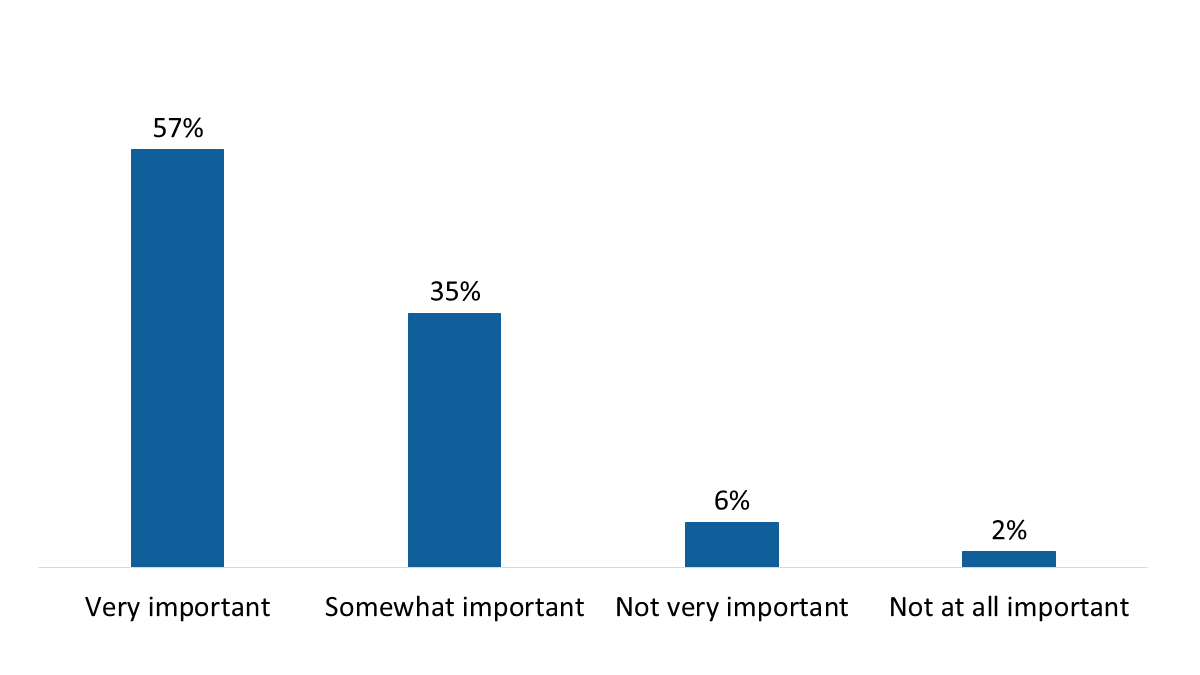
| Very important | 57% |
| Somewhat important | 35% |
| Not very important | 6% |
| Not at all important | 2% |
Q4 - How important is it for you to stay informed through the news? Base: n=1,226; all respondents, excluding “don’t know” n=5.
Approximately six in ten (59%) surveyed Canadians reported consuming Canadians news daily. Most of the rest do so several times a week (25%) or once a week (10%). Relatively few (7%) rarely consume Canadian news.
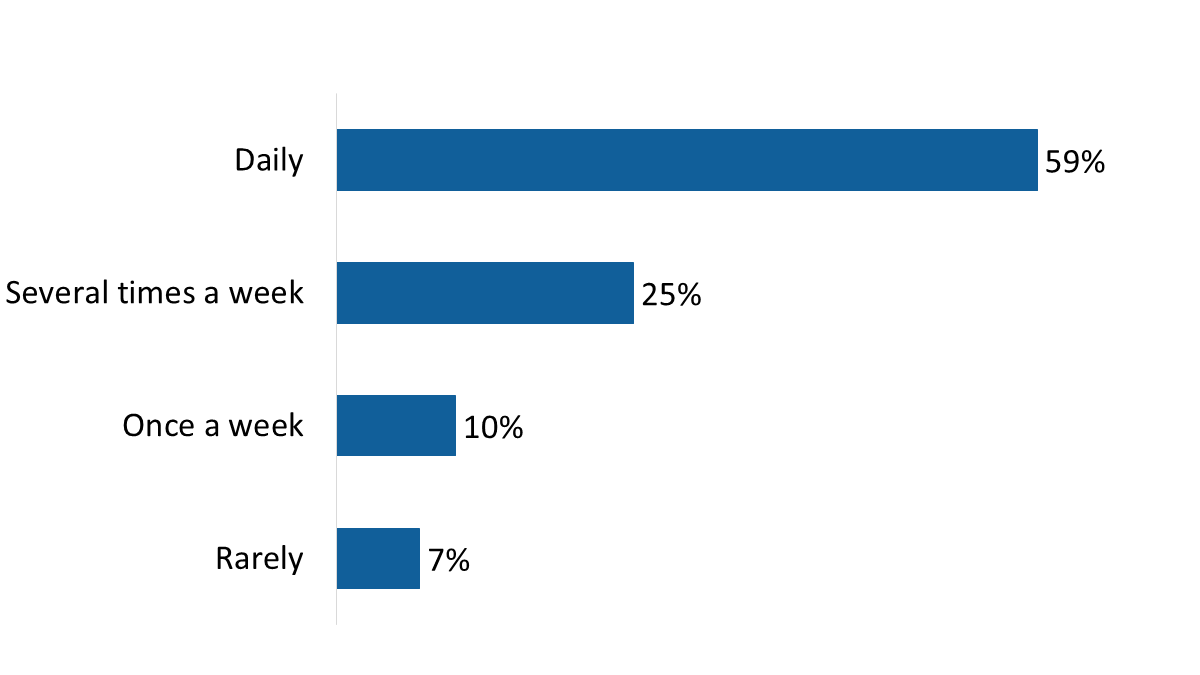
| Daily | 59% |
| Several times a week | 25% |
| Once a week | 10% |
| Rarely | 7% |
Q17 - How often do you consume Canadian news? Base: n=1,226; all respondents.
Survey respondents under 35 years of age were least likely to report that they consume Canadian news on a daily basis.
The majority of respondents are most interested in national news (79%), followed by local (73%) and international (71%) news.Footnote 11 As detailed in Figure 15, comparatively few identified other types of news or new subjects when asked what interests them the most. The “other” category includes news on science, politics, and the environment.
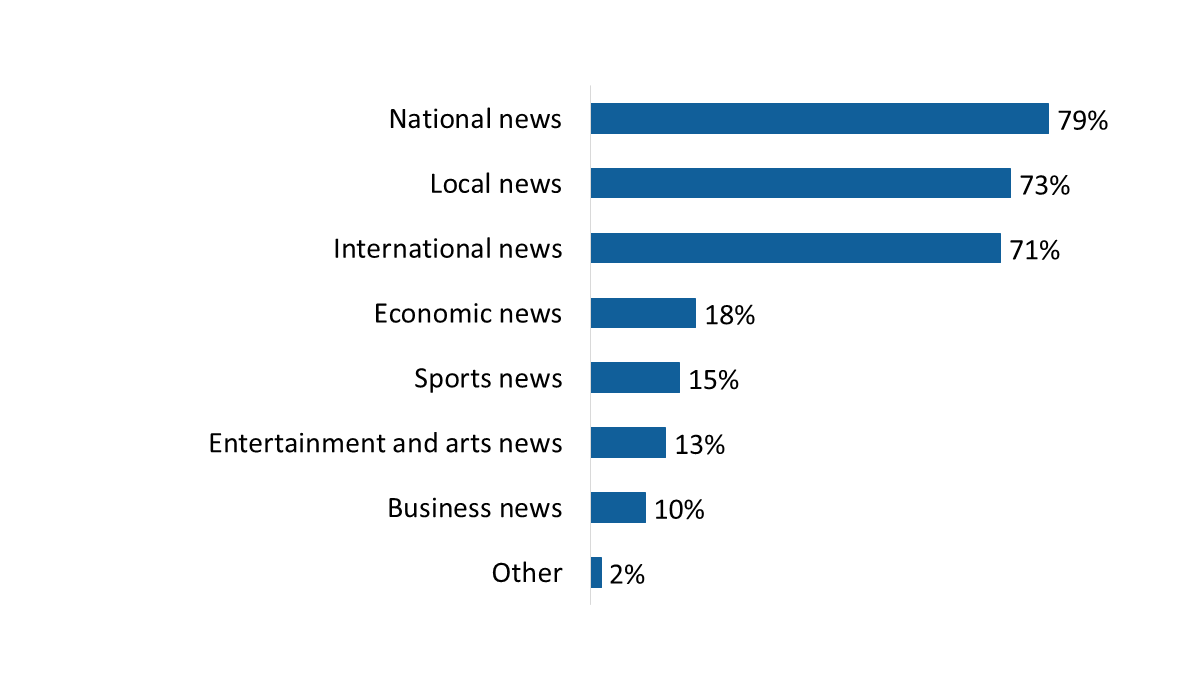
| National news | 79% |
| Local news | 73% |
| International news | 71% |
| Economic news | 18% |
| Sports news | 15% |
| Entertainment and arts news | 13% |
| Business news | 10% |
| Other | 2% |
Q15 - What type of news or which news subject are you most interested in? [Multiple responses accepted] Base: n=1,226; all respondents. Respondents were able to select from a list of responses, as well as volunteer other types of news or news subjects.
Survey respondents reported using a variety of sources to consume Canadian news, including online news (66%), followed by cable or satellite TV (49%), social media (46%), and radio (43%). Fifteen percent said they most often use print newspapers or podcasts. The “other” category below includes Google News, RSS feeds, and family members.
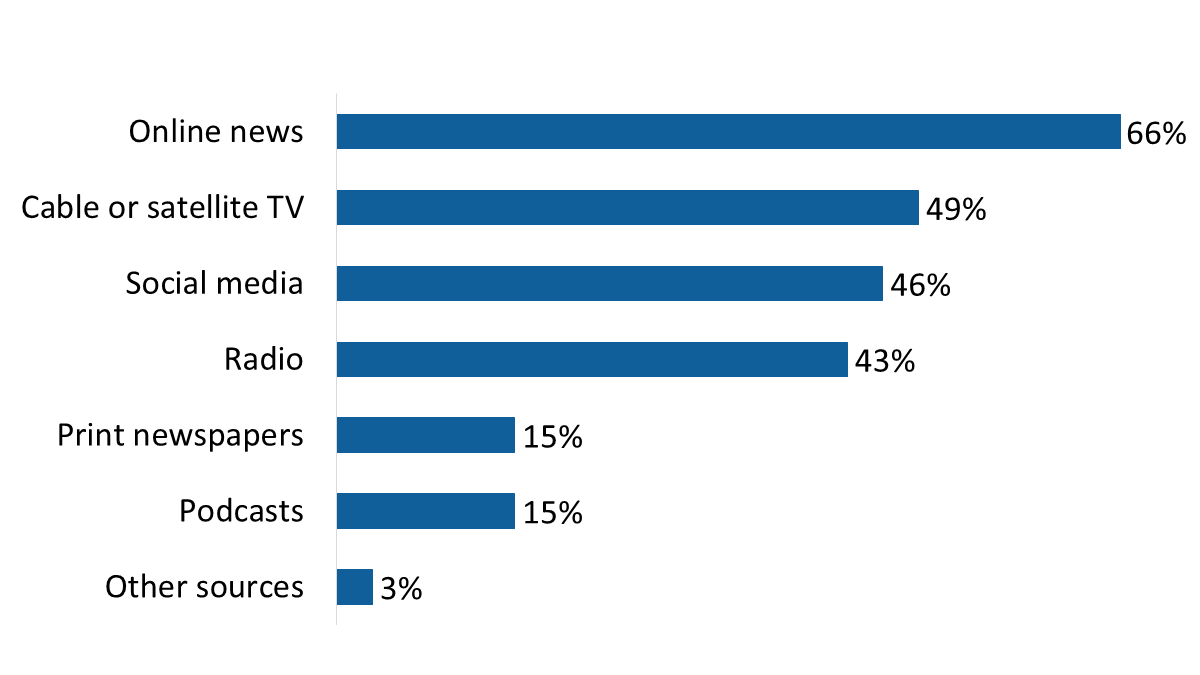
| Online news | 66% |
| Cable or satellite TV | 49% |
| Social media | 46% |
| Radio | 43% |
| Print newspapers | 15% |
| Podcasts | 15% |
| Other sources | 3% |
Q18 - Which sources do you use most often to consume Canadian news? [Up to 3 responses accepted] Base: n=1,226; all respondents. Respondents were able to select from a list of responses, as well as volunteer other sources.
Canadians under 35 years were more likely than older Canadians to say they use podcasts, social media and online news websites and apps to consume Canadian news.
Nine in ten Canadians surveyed (90%) prioritized trustworthiness when it comes to selecting Canadian news sources. Other priorities included local and regional focus (56%), ease of access (46%), and timeliness (31%). Seventeen percent said one of their top priorities when selecting Canadian news sources is user-friendliness.
Eight percent identified other priorities, including truthfulness, non-biased and balanced reporting, quality, and objectivity.
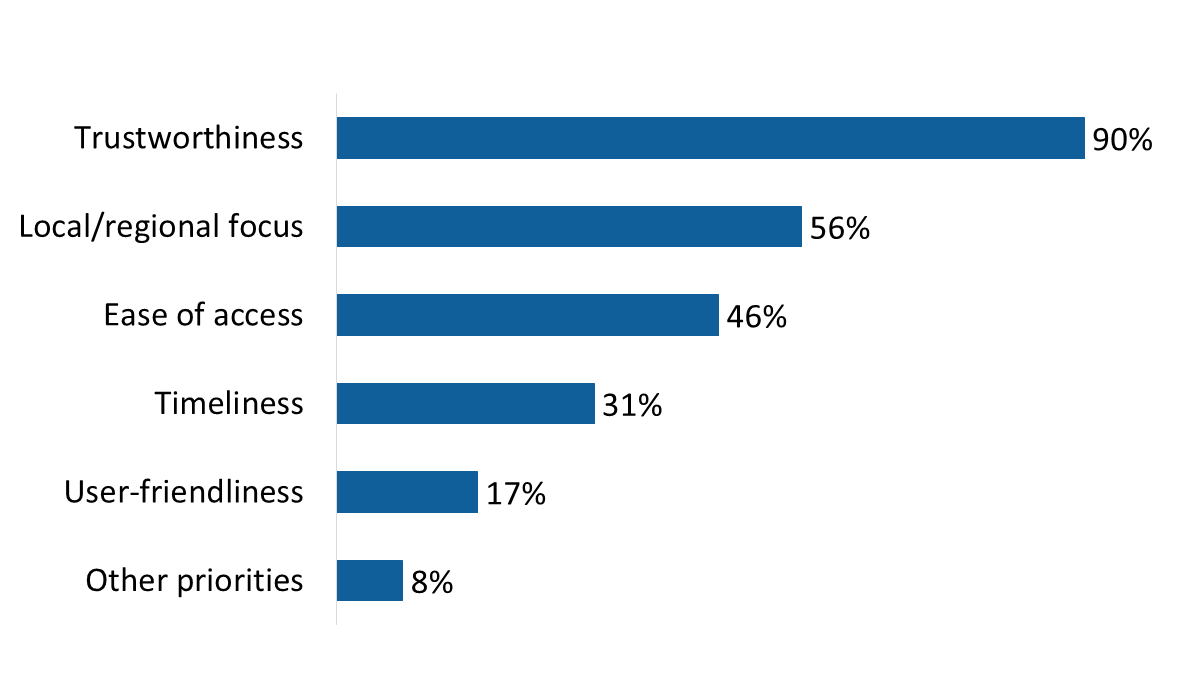
| Trustworthiness | 90% |
| Local/regional focus | 56% |
| Ease of access | 46% |
| Timeliness | 31% |
| User-friendliness | 17% |
| Other priorities | 8% |
Q19 - What are your top priorities when it comes to selecting Canadian news sources? [Up to 3 responses accepted] Base: n=1,226; all respondents, excluding “don’t know” n=10. Respondents were able to select from a list of responses, as well as volunteer other priorities.
Canadians under 35 years of age were less likely to attribute priority to local and regional focus and more likely to prioritize ease of access and user-friendliness.
The vast majority of surveyed Canadians (89%) agreed that it is important that a news source provides a balance between local, national, and international coverage, with over half (56%) agreeing strongly. Almost as many (85%) said they can differentiate between reliable and unreliable news sources, while just over three-quarters (77%) agreed that they have access to reliable news.
Approximately two-thirds (68%) agreed that their local issues are reflected in the news available in their area and roughly six in ten (62%) said the news they have access to presents a variety of viewpoints. When it comes to coverage of local issues and the diversity of viewpoints, respondents offered more moderate assessments, with only two in ten strongly agreeing that Canadian news coverage of these issues is adequate.
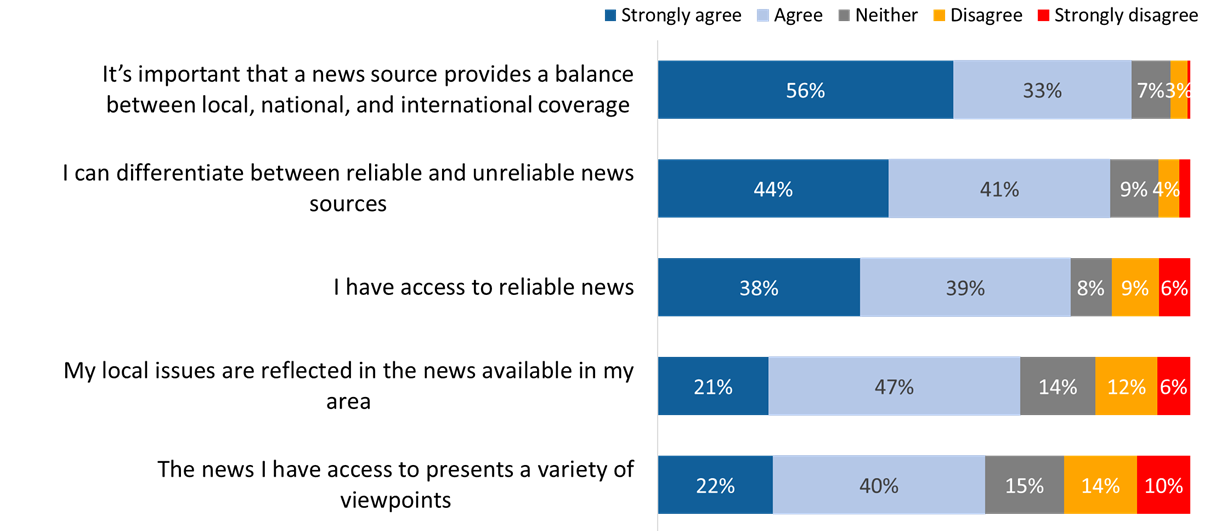
| Strongly agree | Agree | Neither | Disagree | Strongly disagree | |
| The news I have access to presents a variety of viewpoints | 22% | 40% | 15% | 14% | 10% |
| My local issues are reflected in the news available in my area | 21% | 47% | 14% | 12% | 6% |
| I have access to reliable news | 38% | 39% | 8% | 9% | 6% |
| I can differentiate between reliable and unreliable news sources | 44% | 41% | 9% | 4% | 2% |
| It’s important that a news source provides a balance between local, national, and international coverage | 56% | 33% | 7% | 3% | 1% |
Q20 - To what extent do you agree or disagree with these statements about Canadian news? Base: n=1,226; all respondents, excluding “don’t know” which ranged from n=12 to n=42.
Canadians under 35 were the least likely to strongly agree that the news they have access to presents a variety of viewpoints, while those from rural and northern regions were less likely to agree that local issues are reflected in the news available in their area.
Survey respondents' assessments of the performance of Canadians news sources were mixed. Half or more said news sources represent or report on the following somewhat or very well: a variety of political views (57%), subject matter reflecting Canadians from different economic backgrounds (56%), subject matter important to different age groups (54%), members of racialized populations (54%), members of the 2SLGBTQI+ community (52%), and Indigenous Peoples (50%).
The only other area in which there was a consensus was regarding the adequate representation of Canadians living in remote and rural communities, with 55% of those surveyed saying Canadian news sources do this not very or not at all well. More respondents offered a negative assessment of news sources’ representation of or reporting on people with disabilities (44%, compared to 38% who offered a favourable assessment).
Respondents’ views of OLMC news coverage were divided, with almost as many providing favourable (35%) and negative (36%) assessments. The rest (30%) were unsure how to rate the performance of Canadian news sources.
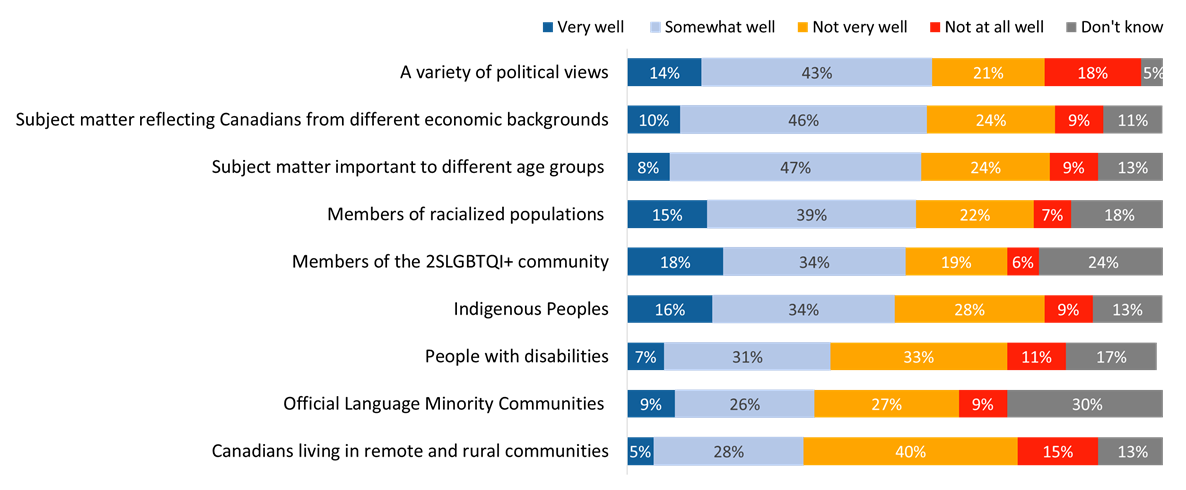
| Very well | Somewhat well | Not very well | Not at all well | Don't know | |
| Canadians living in remote and rural communities | 5% | 28% | 40% | 15% | 13% |
| Official Language Minority Communities | 9% | 26% | 27% | 9% | 30% |
| People with disabilities | 7% | 31% | 33% | 11% | 17% |
| Indigenous Peoples | 16% | 34% | 28% | 9% | 13% |
| Members of the 2SLGBTQI+ community | 18% | 34% | 19% | 6% | 24% |
| Members of racialized populations | 15% | 39% | 22% | 7% | 18% |
| Subject matter important to different age groups | 8% | 47% | 24% | 9% | 13% |
| Subject matter reflecting Canadians from different economic backgrounds | 10% | 46% | 24% | 9% | 11% |
| A variety of political views | 14% | 43% | 21% | 18% | 5% |
Q16- In your opinion, how well do Canadian news sources represent or report on the following? Base: n=1,226; all respondents.
Perceptions of Canadian news sources varied by subgroup—specifically:
More than eight in ten Canadians surveyed (86%) are at least somewhat confident that they can identify misinformation or fake news, including 36% who are very confident. Few are not confident (11% are not very confident and 2% are not all confident).
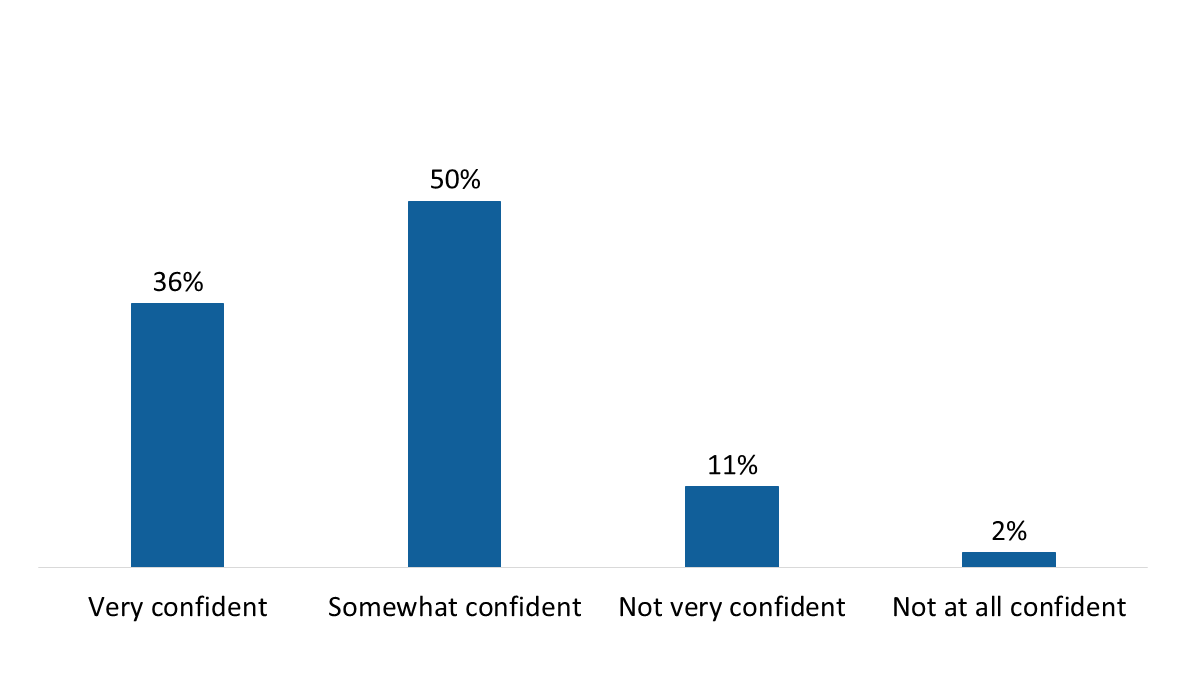
| Very confident | 36% |
| Somewhat confident | 50% |
| Not very confident | 11% |
| Not at all confident | 2% |
Q21 - Do you feel confident that you can identify misinformation or fake news? Base: n=1,226; all respondents, excluding “don’t know” n=12.
Racialized respondents were less likely than non-racialized respondents to feel confident that they can identify misinformation.
Almost as many Canadians surveyed (79%) are at least somewhat confident that the news they consume from Canadian sources is accurate, including 26% who are very confident. Two in ten are not very confident (12%) or not all confident (8%).
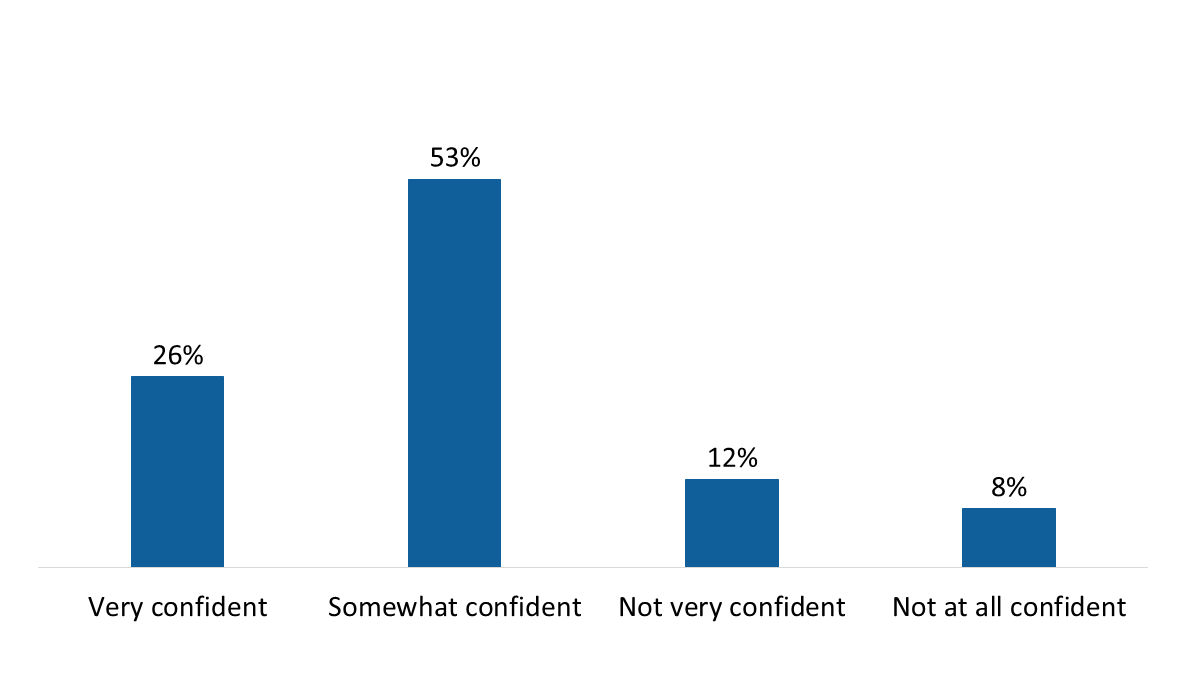
| Very confident | 26% |
| Somewhat confident | 53% |
| Not very confident | 12% |
| Not at all confident | 8% |
Q22 - All things considered, how confident are you in the accuracy of the news you consume from Canadian sources? Base: n=1,226; all respondents, excluding “don’t know” n=16.
Asked how often they consume news, in either video or audio format, most participants said they do so on a daily basis. Others said they do not seek out news daily and their consumption is influenced more by how they feel or whether there are breaking news events or stories that catch their attention. A few participants specified that they find news in general is negative and depressing and they tend to limit their consumption of it.
Participants identified a variety of platforms through which they consume news. While some identified mainstream TV network news broadcasts and radio, most identified online sources such as news sites (e.g., news agencies, digital newspapers), feeds through social media platforms (e.g., X, Facebook, YouTube, Instagram), and podcasts. Devices through which news in video format is consumed include televisions, tablets, computers, and phones. Although the focus was on video and audio formats some participants indicated that they get news through newspapers.
Participants’ descriptions of how and when they consume news exemplifies one of the ways in which their viewing habits have changed over time. While some participants with cable or satellite TV still watch or listen to regularly scheduled news broadcasts, many indicated that they play an active role in their consumption of news and have more control over their viewing habits. This manifests itself in the following ways:
Participants collectively identified a variety of news stories that interest them most. Many identified preferences related to location, with some interested in a mix of local, national, and international news. Francophone participants from Quebec were most likely to identify an interest in regional politics that focus on Quebec. Specific topics of interest included the following:
|
|
Participants identified the following as top priorities when it comes to selecting news coverage:
Views differed about the importance of news sources providing a balance of local and national news coverage. Participants from rural areas and the North considered this balance important, with some indicating that their regions tend to get less coverage in national news. They highlighted the importance of knowing what is going on both within and outside one’s community, the impression that local affairs can be impacted by national issues, their curiosity about what is happening in other parts of the country, and their desire to be exposed to different perspectives on issues.
Participants who felt this balance was not really important explained that they use different sources for their news, with specific sources selected for local news. Consequently, they did not think a single news source is needed to provide both national and local coverage.
Most participants said they believe that the news available in their area reflects their realities and localities. Participants thought that the best sources for local news included local or regional stations of national broadcasters, local radio stations, local newspapers, municipalities’ websites, and local newsletters. Participants who thought the news available in their area could do a better job at including local content tended to be from rural and northern communities. Among these participants, there was an impression that news tended to filter them out and focus more on larger urban centres than on their community.
Relatively few participants identified specific news sources as ones they trust most. Trusted news sources identified most often were the CBC among Anglophone participants and Radio Canada among Francophone participants. Other specific news sources identified included CTV, TVA, and Reuters. Specific newspapers, including Le Devoir and La Presse, were identified by a fews Francophone participants. Some participants said they mostly trust independent news sources (as opposed to Government-funded and privately owned outlets), and a few specified that they most trust local sources (e.g., radio station 98.5 in Montreal) for local news. Some indicated that there is no single source they trust most, adding that they tend to consult a variety of news sources to see how perspectives differ or to validate the consistency of what is reported.
When asked why they trust the sources they do, participants tended to re-iterate their top priorities when it comes to selecting news coverage. Some said that the status of the news source is also a factor, and they considered public broadcasters more trustworthy because they are publicly funded as opposed to privately owned. On the other hand, a few participants indicated that they trust small independent news sources because they are not funded by government, nor owned by individuals, and this independence helps ensure their neutrality and impartiality. Finally, some participants said they mostly trust local news sources that are on the spot and best able to cover local affairs with accuracy.
Participants said they use the following criteria to differentiate between reliable and unreliable sources:
Many participants said that reliability is assessed in part by comparing sources, with some suggesting that biases, agendas, or different perspectives will always exist when it comes to media reporting. As a result, they considered it important to be able to identify biases, try to filter them out, and come to one’s own conclusions by consulting a variety of sources.
Many participants indicated they have consumed content that first appeared to be news, but later felt more like an advertisement. Their reaction was consistently negative and included anger, disappointment, annoyance at having wasted one’s time, disinterest in the product or service, a feeling of having been misled, deceived, or tricked, and a loss of confidence in the credibility of the outlet publishing the advertorials.
Participants looked for the following characteristics of advertorials to differentiate them from news articles:
When asked, most participants said that publishing advertorials would affect their trust in a news outlet, though some specified that this would only be the case if the outlet did not make it clear that the piece was an advertorial. Reasons for diminished trust included the following:
Some participants said that the extent to which their trust would be affected would depend on what exactly was being promoted. Others indicated their trust would not be affected as all news outlets publish advertorials as a way to generate revenue.
There was widespread agreement that news organizations should take measures to help identify advertorials by clearly and explicitly identifying an article as an advertorial at the beginning of the piece.
This section focuses on issues related to artificial intelligence (AI) and its use in news programming. This topic was covered in the focus groups only.
Nearly all focus group participants said they have little to no familiarity with the use of AI in news programming, but the majority thought that it is important or very important to know whether the news programming they consume was created using AI. Focus group participants considered this important for the following reasons:
A few participants said it would not be important for them to know whether AI has been used in the creation of news programming they consume, as long as the content itself was true. Others responded that it would depend on specifically which AI was being used.
On the other hand, some participants indicated that knowing AI has been used in content creation would affect their habits when it comes to watching news. A few said they did not know to what extent this knowledge would be important to them because they know so little about AI.
Only a few participants indicated that they have encountered news programming they suspect was generated by AI. In one instance, this involved a newscaster providing an example of how AI could be used to generate a deepfake.
There was a widespread impression among participants that AI could have an impact on the quality and reliability of news programming. Some participants specified that this would depend on what it was used for and the intelligence of those using it. Other perceived impacts of AI were more likely to be negative than positive and included the following:
On a more positive note, it was recognized that AI is a powerful tool that can be useful if properly regulated. For example, AI could get warnings and bulletins out faster and pull together useful statistical data based on accurate information.
This research study was designed to assess Canadians’ views on audiovisual Canadian programming and news, in preparation for developing new policies following amendments to the Broadcasting Act. What follows below is a brief discussion of the findings from both components of the research as they relate to the study objectives.
A key goal of this research was to understand how people value Canadian programming. Most survey respondents agreed that it’s important for Canadian programming to reflect Canadian culture. To understand why, focus group participants offered some insights. They explained that watching Canadian programming gives them a sense of pride and connection. They appreciate its quality, diversity, and relatability in representing Canadians, Québécois, or Francophone-Canadians. While Canadians value Canadian programming, country of origin is not important to almost half of those surveyed. To understand this apparent contradiction, focus group participants provided some perspective when asked to explain why they watch Canadian programming. Indeed, the reasons for choosing programming are driven more by its news and entertainment value rather than elements of Canadian content.
Quality programming was a key theme in the research. Focus group participants associated Canadian programming with quality. They cited quality as a reason they watch Canadian programming and highlighted it as one of the factors they most value. In the survey, nearly three-quarters of Canadians said overall quality is a top factor in their decision to watch a program. When discussing news coverage, focus group participants prioritized trustworthiness, credibility, reliability, and in-depth reporting—factors that define “quality” coverage. Similarly, survey respondents overwhelmingly prioritized trustworthiness when choosing Canadian news sources.
Quebec/French-language programming is a unique part of Canadian programming. Francophone focus group participants from Quebec consistently emphasized the distinctly Quebec or French-language dimension of Canadian programming, whether it be identifying feeling pride, or feeling connected to Canadian programming. That is not to say that Francophone participants from Quebec did not recognize Canadian programming outside of Quebec—they just found Canadian programming most meaningful when it comes from Quebec. The survey results also showed that Francophones from Quebec and French OLMC members were more likely than other Canadians to consider a program’s country of origin important.
Diversity in Canada and Quebec was a focal point in the focus group discussions about whether Canadian programming reflects Canadian culture and values. There was widespread agreement that diversity is a core element of Canada’s and Quebec’s culture. Based on this, many participants felt that Canadian and Quebec/French-language programming accurately represent Canadian and Quebec culture and values because they showcase this diversity. Others, however, believed that this diversity makes it difficult to identify Canadian and Quebec culture or values in a clear and definitive way.
Canadians generally have a positive view of Canadian news, with over three-quarters of survey respondents agreeing they have access to reliable news. However, participants suggested that Canadian news sources could do a better job when it comes to covering issues of relevance to rural and northern communities. While most survey respondents feel local issues are reflected in the news available in their area, those living in rural or northern areas are less likely than Canadians living in urban areas to feel this way. This concern was also shared by some of the focus group participants living outside urban centres, who felt that news overage often prioritizes larger cities over their communities.
The research highlights the importance of quality news programming, with trustworthiness being a top priority for both survey respondents and focus group participants when selecting Canadian news sources. When asked to assess Canadian news, most survey respondents said they are at least somewhat confident in the accuracy of Canadian news and feel it presents a variety of viewpoints. Half or more believe Canadian news sources report well on different political viewpoints and subject matter reflecting different economic backgrounds, age groups, racialized populations, the 2SLGBTQI+ community, and Indigenous Peoples. However, survey respondents said Canadian news coverage is weaker when it addresses people with disabilities, OLMCs, and Canadians living in remote and rural communities.
The following specifications applied to the survey:
| Total (n) | |
|---|---|
| Total phone numbers attempted = I + U + IS + R | 8,058 |
| Out-of-scope - Invalid (I) | 727 |
| Unresolved (U) | 1,234 |
| No answer/answering machine/busy | 1,234 |
| In-scope - Non-responding (IS) | 4,600 |
| Language problem, illness, incapable | 5 |
| Selected respondent not available | 6 |
| Household refusal | 281 |
| Respondent refusal | 4,286 |
| Qualified respondent break-off/partial complete | 22 |
| In-scope - Responding units (R) | 1,497 |
| Completed the survey | 1,226 |
| Terminate, prefer not provide province/territory or gender | 37 |
| Terminate, not 16 years of age | 14 |
| Terminate, does not watch video programming or news | 35 |
| Terminate, participated in a Government of Canada survey in the last 30 days | 185 |
| Response rate = R / (U + IS + R) | 20.4% |
| Variable | % Unweighted |
% Weighted |
|---|---|---|
| Gender | ||
| Man | 52% | 49% |
| Woman | 48% | 51% |
| Region Footnote 12 | ||
| Atlantic Canada | 7% | 6% |
| Quebec | 26% | 24% |
| Ontario | 38% | 39% |
| Prairies | 15% | 17% |
| British Columbia | 14% | 15% |
| Age | ||
| 16-34 | 19% | 28% |
| 35-54 | 32% | 31% |
| 55-64 | 20% | 17% |
| 65+ | 29% | 23% |
The following specifications applied to the survey:
| Day 1 [Pre-test] | Day 2 | Day 3 | Day 4 | Day 5 |
|---|---|---|---|---|
| Group 1 | Group 2 | Group 4 | Group 6 | Group 7 |
| English-language Canadians living in urban area 7:00 pm Eastern |
English-language OLMCs 6:00 pm Eastern |
English-language equity-deserving groups 7:00 pm Eastern |
English-language Canadians living in rural area and in the North 8:00 pm Eastern |
French-language equity-deserving groups 5:00 pm Eastern |
| Group 3 | Group 5 | Group 8 | ||
| French-language Canadians living in rural area and in the North 8:00 pm Eastern |
French-language Canadians living in urban area 6:00 pm Eastern |
French-language OLMCs 7:00 pm Eastern |
The tables in this section present profiles of the research participants.
| Province/Territory | Weighted percentage of the survey sample |
|---|---|
| Alberta | 9% |
| British Columbia | 15% |
| Manitoba | 5% |
| New Brunswick | 2% |
| Newfoundland and Labrador | 1% |
| Nova Scotia | 3% |
| Ontario | 39% |
| Prince Edward Island | 1% |
| Quebec | 18% |
| Saskatchewan | 3% |
| Territories | <1% |
| No response | 6% |
| Age | Weighted percentage of the survey sample |
|---|---|
| 16 to 24 years old | 5% |
| 25 to 34 years old | 24% |
| 35 to 54 years old | 31% |
| 55 years old or older | 40% |
| Education | Weighted percentage of the survey sample |
|---|---|
| Elementary school or less | 1% |
| Secondary school | 6% |
| Some post secondary | 8% |
| College, vocational or trade school | 26% |
| Undergraduate university program | 28% |
| Graduate or professional university program | 30% |
| No response | 2% |
| Household income | Weighted percentage of the survey sample |
|---|---|
| Under $20,000 | 4% |
| $20,000 to just under $40,000 | 6% |
| $40,000 to just under $60,000 | 10% |
| $60,000 to just under $80,000 | 12% |
| $80,000 to just under $100,000 | 14% |
| $100,000 to just under $150,000 | 23% |
| $150,000 and above | 22% |
| No response | 9% |
| Disability | Weighted percentage of the survey sample |
|---|---|
| No disability | 82% |
| Living with a disability | 17% |
| No response | 2% |
| Indigenous person | Weighted percentage of the survey sample |
|---|---|
| Indigenous | 3% |
| Non-Indigenous | 96% |
| No response | 2% |
| Language spoken at home | Weighted percentage of the survey sample |
|---|---|
| English | 76% |
| French | 25% |
| Other languages | 7% |
*Multiple responses accepted
| Official language minority community | Weighted percentage of the survey sample |
|---|---|
| OLMC | 14% |
| Non-OLMC | 85% |
| No response | 1% |
| Location | Weighted percentage of the survey sample |
|---|---|
| Urban | 89% |
| Rural and north | 11% |
| Racialized communities | Weighted percentage of the survey sample |
|---|---|
| Racialized | 15% |
| Non-racialized | 81% |
| No response | 4% |
| 2SLGBTQI+ community | Weighted percentage of the survey sample |
|---|---|
| 2SLGBTQI+ | 14% |
| Not 2SLGBTQI+ | 84% |
| No response | 2% |
| Region | Number of focus group participants |
|---|---|
| West and Territories | 14 |
| Ontario | 9 |
| Quebec | 30 |
| Atlantic | 10 |
| Location | Number of focus group participants |
|---|---|
| Rural | 16 |
| Urban | 47 |
| Age | Number of focus group participants |
|---|---|
| 18 to 24 | 3 |
| 25 to 34 | 9 |
| 35 to 44 | 7 |
| 45 to 54 | 16 |
| 55 to 64 | 18 |
| 65+ | 10 |
| Gender | Number of focus group participants |
|---|---|
| Man | 30 |
| Woman | 33 |
| Education | Number of focus group participants |
|---|---|
| High school or less | 3 |
| College | 21 |
| Trades | 3 |
| Some university | 3 |
| Bachelor's degree | 19 |
| Post graduate degree | 14 |
| Equity-deserving groups | Number of focus group participants |
|---|---|
| Racialized | 11 |
| Disability | 8 |
| 2SLGBTQI+ | 3 |
| OLMC (English) | 7 |
| OLMC (French) | 9 |
Survey Introduction Page
Thank you for agreeing to take part in this short survey being conducted on behalf of the Canadian Radio-television and Telecommunications Commission (CRTC) by Phoenix Strategic Perspectives (Phoenix SPI). Si vous préférez répondre au sondage en français, veuillez cliquer sur « Français » dans le coin supérieur droit.
This survey is designed to collect information on issues related to entertainment and news programming in Canada. The survey should take no more than 10 minutes to complete and will be kept completely confidential. The information provided will be administered according to the requirements of the Privacy Act. Your responses will not be used to identify you, and none of your opinions will be attributed to you personally in any way. To view Phoenix SPI’s privacy policy, click <here>.
This survey is registered with the Canadian Research Insights Council’s Research Verification Service. The project verification code is INSERT. Click <here> to verify the legitimacy of this survey.
The survey conforms with the Web Content Accessibility Guidelines designed to ensure websites and digital content are more accessible for people with disabilities. Should you require an alternate method of completing this survey, please click <here> to contact us.
Screening questions
S1. In which year were you born?
S2. [IF S1=2008] Are you at least 16 years of age?
S3. [IF S1=02] In which age category do you belong?
S4. Which of the following do you do at least once a week?
S5. Are you a member of an Official Language Minority Community (OLMC)? This refers to a community of people whose Official language spoken at home is not the majority language spoken in their province or territory (e.g., English speaker who resides in Quebec, or a French speaker who resides outside of Quebec).
S6. What are the first 3 characters of your postal code?
S7. In the previous 30 days, have you participated in any of the following?
Select all that apply
S8. In which province or territory do you currently live?
S9. By which gender do you identify?
Media Habits
1. How do you typically access video programming?
Select all that apply
2. How often do you watch video programming in a typical day? This includes video programming on cable or satellite TV services or online streaming services, like Disney+.
3. What type of video programming do you primarily watch?
Select all that apply
4. How important is it for you to stay informed through the news?
Canadian Programming
Canadian video programming refers to media productions, such as films, series and sitcoms, and videos, that are created in Canada or by Canadians.
This next set of questions focuses on Canadian video programming available through cable or satellite subscriptions or online streaming services, like Apple TV.
5. Can you identify Canadian programming when looking for something to watch on cable, satellite or online streaming services?
6. How important to you, if at all, is a program’s country of origin? “Country of origin” refers to where the video programming, such as a film, series, sitcom, or video, was created or produced.
7. How do you identify Canadian programming?
8. What factors influence your decision to watch video programming?
Select all that apply
9. How often do you watch Canadian programming?
10. [ASK IF Q9 = 01-03, 05] What type(s) of Canadian programming matters to you the most?
Select up to 3 responses
11. How do you discover new Canadian programming to watch?
Select all that apply
12. How important is it to you that Canadian programming reflects Canadian culture and identity?
Part of CRTC’s role is to ensure that creators receive the necessary support so that they can create their stories and have them distributed both in Canada and abroad. At the same time, the CRTC ensures that Canadians have access to diverse programming that meets their needs and interests.
13. Considering this, how important to you are each of the following priorities?
ROTATE ITEMS
Response Options
14. [DISPLAY THE ITEMS RATED A ‘1’ OR ‘2’ AT Q13] Which of these priorities do you consider most important?
Select up to 3 responses
SHOW ITEMS IDENTIFIED AT Q13
News
The focus of this next set of questions is on audio and video news content consumed through any platform, including TV cable and satellite services, online news sites or apps, social media, or radio.
15. What type of news or which news subjects are you most interested in?
Select up to 3 responses
16. In your opinion, how well do Canadian news sources represent or report on the following?
[ROTATE ITEMS]
*OLMCs refers to a community of people whose Official language spoken at home is not the majority language spoken in their province or territory.
Response Options
17. How often do you consume Canadian news?
18. Which sources do you use most often to consume Canadian news?
Select up to 3 responses
19. What are your top priorities when it comes to selecting Canadian news sources?
Select up to 3 responses
20. To what extent do you agree or disagree with the following statements about Canadian news?
[ROTATE ITEMS]
21. Do you feel confident that you can identify misinformation or fake news?
22. All things considered, how confident are you in the accuracy of the news you consume from Canadian sources?
Demographics
We have a couple of final questions for statistical classification purposes. Be assured that your responses will be held in strict confidence.
D1. What is the highest level of formal education that you have completed to date?
D2. Which of the following categories best describes your total household income last year, before taxes, from all sources for all household members?
D3. What language do you speak most often at home?
Select all that apply
D4. Do you identify as a person with a disability? A person with a disability is a person who has a long-term or recurring impairment (such as vision, hearing, mobility, flexibility, dexterity, pain, learning, developmental, memory, or mental health-related) which limits their daily activities inside or outside the home (such as at school, work, or in the community in general).
D5. Are you First Nations, Métis, or Inuk (Inuit)?
D6. [SKIP IF D5=02-04] What is your racial background? [02 THROUGH 10 = CODE AS RACIALIZED]
D7. Do you identify as part of the 2SLGBTQI+ community?
Closing page
That concludes the survey. This survey was conducted on behalf of the CRTC. In the coming months, a report with the findings from this study will be available to the public on the Library and Archives Canada website (Library and Archives Canada/). Thank you very much for taking part. Your participation is appreciated.
Introduction
Hello/Bonjour, my name is [INSERT]. I’m calling from Phoenix Strategic Perspectives, a Canadian public opinion research firm. Would you prefer to continue in English or French? / Préférez-vous continuer en français ou en anglais?
Intro1. Language:
[RECRUITER NOTE: FOR ENGLISH GROUPS, IF THE INDIVIDUAL WOULD PREFER TO CONTINUE IN FRENCH, PLEASE CONTINUE IN FRENCH AND RECRUIT FOR THE FRENCH GROUPS. FOR THE FRENCH GROUPS, IF THE INDIVIDUAL WOULD PREFER TO CONTINUE IN ENGLISH, PLEASE CONTINUE IN ENGLISH AND RECRUIT FOR AN OPEN ENGLISH GROUP. FOR GROUPS OUTSIDE OF ONTARIO/THE EASTERN TIME ZONE, FIRST CONFIRM THAT THE SESSION TIME IS ACCEPTABLE.]
Intro2. We are organizing a series of discussion groups on issues of importance to Canadians, on behalf of the CRTC, a Federal Agency. We are looking for people aged 18 and older who would be willing to participate in an online discussion group. Are you at least 18 years of age?
Intro3. Do you identify….
IF ASKED FOR MORE INFORMATION ABOUT THE FOCUS GROUP, PLEASE GO TO INFORMATION AND THEN RETURN TO THE INTRO QUESTIONS.
Intro4. Are you a member of an official language minority community? This refers to a community of people whose preferred language, French or English, is not the majority language spoken in their province or territory.
Intro5. What are the first 3 characters of your postal code?
Information
The online focus groups are being conducted on behalf of the CRTC, an agency of the federal government, to collect input from Canadians on video and news content. Participation is completely voluntary and your decision to participate or not will not affect any dealings you may have with the Government of Canada. We are interested in hearing your opinions; no attempt will be made to sell you anything or change your point of view. The information collected will be used for research purposes only and handled according to the Privacy Act* of Canada. The format is an online discussion with up to 8 participants led by a research professional from Phoenix Strategic Perspectives. All opinions will remain anonymous, and views will be grouped together to ensure that no individual can be identified. Those who participate will receive a cash gift to thank them for their time.
May I continue?
RECRUITER NOTES:
EN: https://www.canadianresearchinsightscouncil.ca/rvs/home/
FR: https://www.canadianresearchinsightscouncil.ca/rvs/home/?lang=fr
Questions
The focus group will take place online on the (INSERT DATE/TIME) and will last up to an hour and a half (1.5 hours).
1. Would you be interested in taking part in this study?
2. Before we invite you to attend, I need to ask you a few questions to ensure that we get a good mix of participants. This will take 5 minutes. May I continue?
3. Do you watch entertainment programming at least once a week? This includes TV programming on cable or satellite TV services, streaming services, or online platforms, like YouTube.
4. How often do you consume news? This can be on any media, including, for example, TV services, online news sites or apps, social media, radio or newspapers.
5. The focus groups are going to be online sessions held over the Internet. Participants will need to have access to a computer, high-speed Internet connection,and a Webcam to participate in the group. The Webcam will need to be turned on for the duration of the session. Would you be able to participate under these conditions?
6. We’ve been asked to speak to participants of all different ages. May I have your age, please? [RECRUIT A MIX IN EACH GROUP]
7. In which province or territory do you live? This information is needed to make sure you are assigned to a focus group that takes place in your time zone. [DO NOT READ LIST] [RECRUIT A MIX IN EACH GROUP]
8. Which gender do you identify as? [RECRUIT A MIX IN EACH GROUP]
9. What is the highest level of formal education that you have completed? [RECRUIT A MIX IN EACH GROUP]
10. Are you an Indigenous person, that is to say, First Nations, Métis, or Inuk (Inuit)?
Participation and Consent
11. Have you ever attended a discussion group or taken part in an interview on any topic that was arranged in advance and for which you received an honorarium for your participation?
12. [IF Q11=01] When did you last attend one of these discussion groups or interviews?
13. [IF Q12=02] Thinking about the groups or interviews that you have taken part in, what were the main topics discussed?
Record: _______________ [Terminate If Related to Media]
14. How many discussion groups have you attended in the past 5 years?
15. The discussion group will be recorded. The recordings will be used only by the research professional to assist in preparing a report on the findings, and they will be destroyed once the report is final. Do you agree to be recorded for research purposes only?
16. [IF Q15=02 OR 03] It is necessary for the analysis process for us to record the session, as the moderator needs this material to complete the report. The recordings will be used only by the research firm to assist with writing the report and will not be shared. Now that I’ve explained this, do I have your permission for recording?
17. Representatives from the CRTC may observe the groups. They will not take part in the discussion. They will be attending to hear your opinions firsthand, although they may take their own notes and confer with the moderator to discuss additional questions to ask the group. Do you agree to be observed by employees of the CRTC?
18. We will provide the focus group moderator with a list of participants’ names so that they can sign you into the group. We will provide your first name and the first letter of your last name, as well as your responses to this questionnaire. Do we have your permission to do this? I assure you it will be kept strictly confidential.
19. [IF Q18=02 OR 03] We need to provide the focus group moderator with the names of the people attending the focus group because only the individuals invited are allowed in the session and the moderator must have this information for verification purposes. Only your first name will be visible when you join the focus group session. Now that I’ve explained this, do I have your permission to provide your name and profile to the moderator?
INVITATION TO PARTICIPATE
You qualify to participate in one of our virtual discussion groups. The discussion will be led by a researcher from the public opinion research firm, Phoenix Strategic Perspectives. The group will take place on [DAY OF WEEK], [DATE], at [TIME], and will last an hour and a half (1.5 hours). If you participate, you will receive an honorarium of $125 for your time.
20. Are you willing to attend?
21. May I have your email address so that we can also send you an email message with the information you will need about the focus group?
ENTER EMAIL ADDRESS: ____________________
Information regarding how to participate will be sent to you by email in the coming days. The email will come from Phoenix SPI and the address will be research@phoenixspi.ca. You will be asked to log in to the online session 10 minutes prior to the start time. If you do not log in on time, you may not be able to participate and you will not receive an honorarium.
As we are inviting only a small number of people to attend, your participation is very important to us. If for some reason you are unable to attend, please call us so that we can find someone to replace you. You can reach us at [INSERT NUMBER] at our office. Please ask for [INSERT NAME].
Someone will call you the day before to remind you about the session. Will you please confirm your name and contact information for me?
Thank you very much for your time and willingness to participate in this research.
Introduction: 5 minutes
→ Introduce moderator/firm and welcome participants to the focus group.
TECHNICAL CHECK; CONFIRM SOUND AND VIDEO QUALITY.
→ Describe focus groups.
→ Explanations.
→ Any questions?
→ Roundtable introduction: Let’s start with everyone introducing themselves, first name only, please.
Context: 15 minutes
When you were recruited for this study, all of you said you watch news and entertainment programming on traditional TV or through online streaming services. I’d like to begin with a few general questions about your viewing habits…
1. What type of programs do you tend to watch? [KEEP BRIEF]
Probe: AS NEEDED:
2. How do you watch these programs… through an online streaming service, a cable or satellite subscription, or both?
3. How do you decide what to watch? What influences your choices?
4. Have your habits changed over the past few years when it comes to watching video programming? If so, how, and why?
Canadian Programming: 25 minutes
5. When you hear the term “Canadian programming”, what comes to mind? What do you see as Canadian programming?
6. How many of you regularly watch Canadian programming? Why is that? Other than news or sports, can anyone name a Canadian show that aired in the last 5 years or so? PROMPT: Shoresy, Schitt’s Creek, Paw Patrol, Workin' Moms, Kim's Convenience, etc.
7. How does watching Canadian programming make you feel about your own identity as a Canadian? Does it make you proud to be Canadian?
8. Generally, what type of programming matters the most to you? What elements in the programming resonate with you?
9. Do you feel that Canadian programming accurately represents Canadian culture and values? Why do you say that?
10. How important is it that the people creating the stories behind the camera have similar experiences to the people whose stories they are telling? For example, people from diverse backgrounds telling stories from their communities.
11. If you were to think about what makes a Canadian program Canadian, what would that include?
In Canada, creators can get their programming certified as Canadians in order to qualify for tax credits and funding, as well as to meet some regulatory requirement to spend on Canadian programming.
I’m going to post a short description of the main criteria that people use to designate a program as a Canadian program. MODERATOR: POST ON SCREEN. READ IF APPROPRIATE.
12. Does anything in the criteria surprise you? If so, what and why? Do you think these criteria are important for designating a program Canadian? Is anything missing in the criteria that you thought would be in there?
News: 30 minutes
Up to this point, we’ve been talking about all types of programming. I’d now like to focus on news specifically.
13. How often do you consume news in either audio or video format, and through which platforms do you consume it?
MODERATOR: IF NEWSPAPERS ARE MENTIONED GOING FORWARD, KEEP THE DISCUSSION FOCUSED ON ELECTRONIC MEDIA – AUDIO AND VISUAL.
14. What types of news stories are you most interested in?
15. What are your top priorities when it comes to selecting news coverage?
16. Turning to local and regional news, is it important that a news source provide a balance between local and national coverage? If so, why?
17. Are your realities and localities reflected in the news available in your area? If so, what are the best sources for local news?
18. Which news sources do you trust the most? Why is that?
19. How do you differentiate between reliable and unreliable news sources? What criteria do you use?
Now we’re going to briefly talk about advertorials. I’m going to post a short description so that we have a shared understanding of what we’re discussing. MODERATOR: POST ON SCREEN. READ IF APPROPRIATE.
An advertorial is a type of advertisement that looks and reads like an article or news story, but its main purpose is to promote a product, service, or brand. It blends “advertisement” with “editorial” which means written content. Advertorials aim to inform and persuade without being overtly promotional.
20. Have you ever come across content that appeared to be news but later felt more like an advertisement? If so, how did this make you feel?
21. How do you differentiate between a news article and an advertorial? What specific elements or signals help you identify the difference?
22. When a news organization publishes advertorial content, does it affect your trust in that news outlet and, if so, how?
23. Should news organizations take measures to help you distinguish between paid content and advertorials? What measures should they take and why?
Artificial Intelligence: 10 minutes
The last thing I’d like to briefly discuss is AI or artificial intelligence and its use in news programming.
24. How familiar are you with the use of AI in news programming?
25. How important is it for you to know whether AI has been used in the creation of content you consume? Why is that? Would it affect your viewing habits?
26. Have you ever encountered news programming that you suspect was generated by AI? If so, do you think AI could have an impact on the quality and reliability of that content? What about other possible impacts of AI?
Conclusion: 5 minutes
We’ve covered a lot tonight and I really appreciate you taking the time to share your opinions.
27. Does anyone have any last thoughts or feedback to share with the CRTC about the topic?
On behalf of the CRTC, I would like to thank you for your time and participation today. The honorarium will be available through the recruiter.
You can all log out now. Have a great evening!